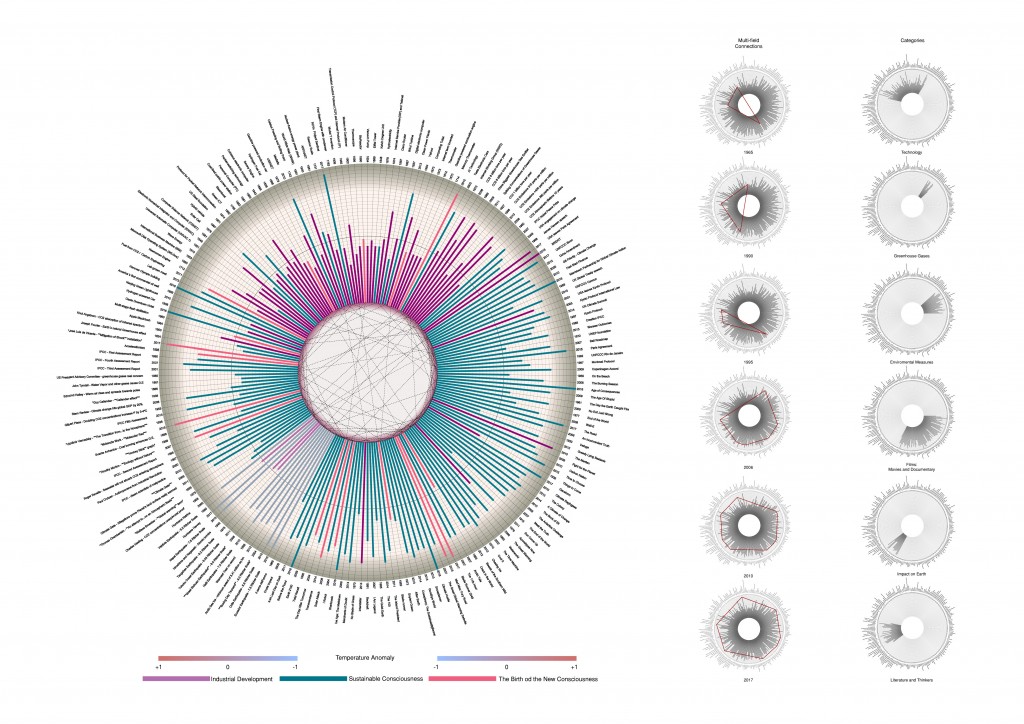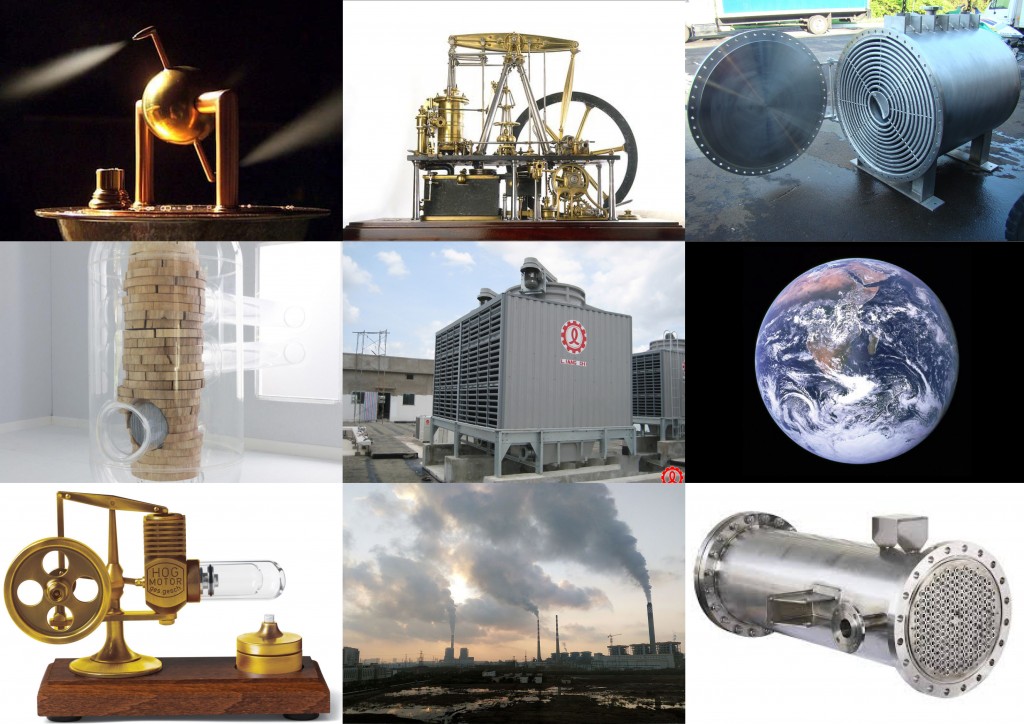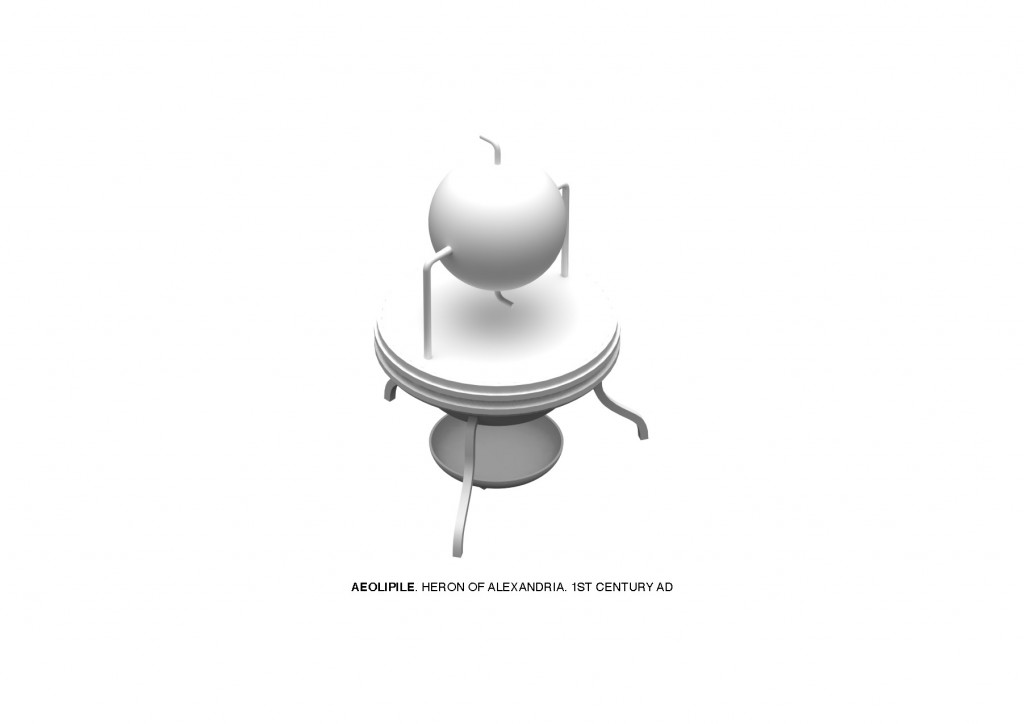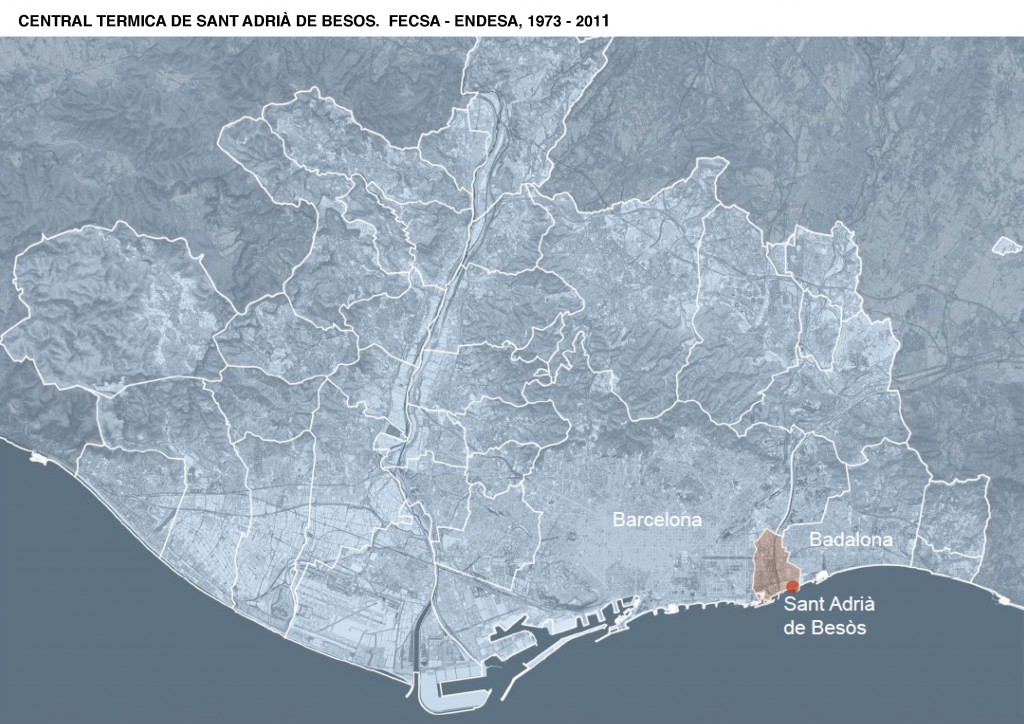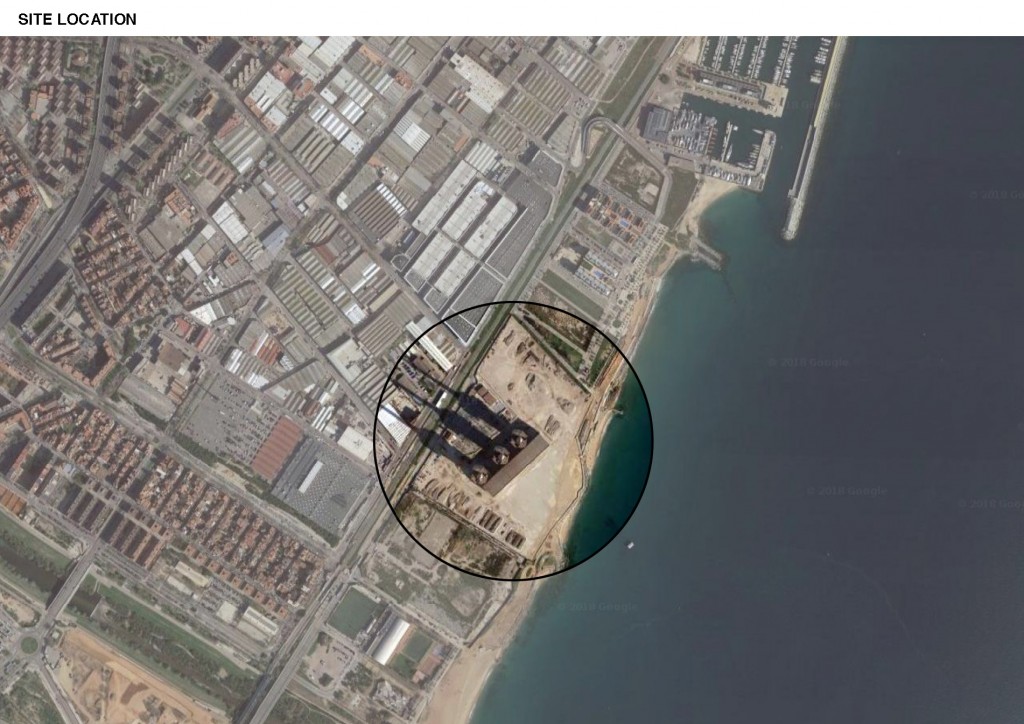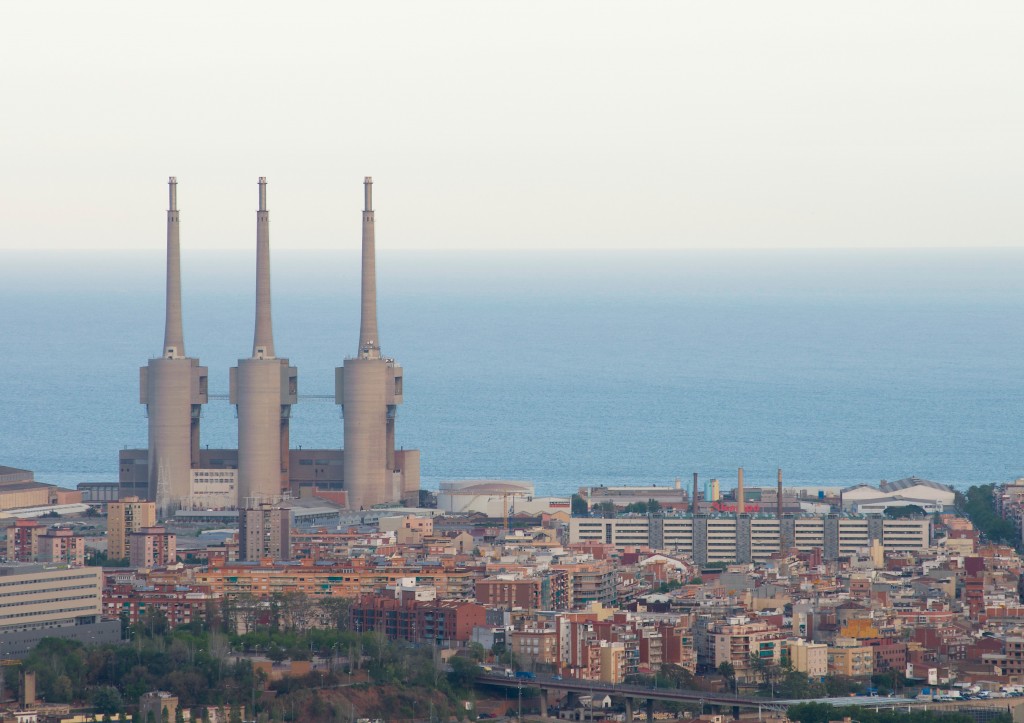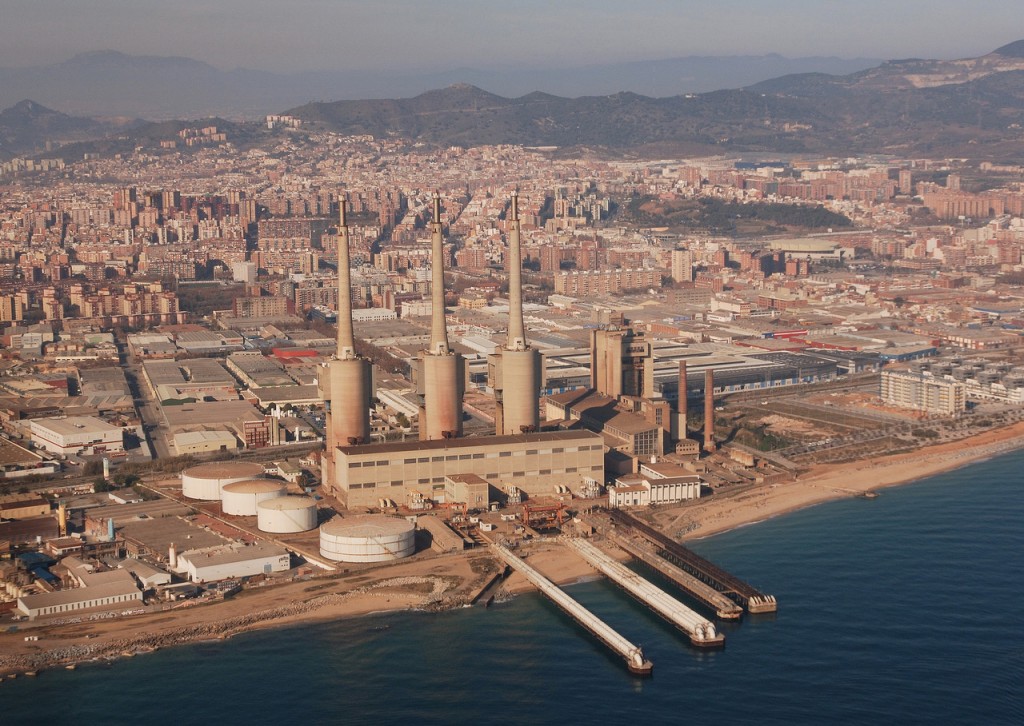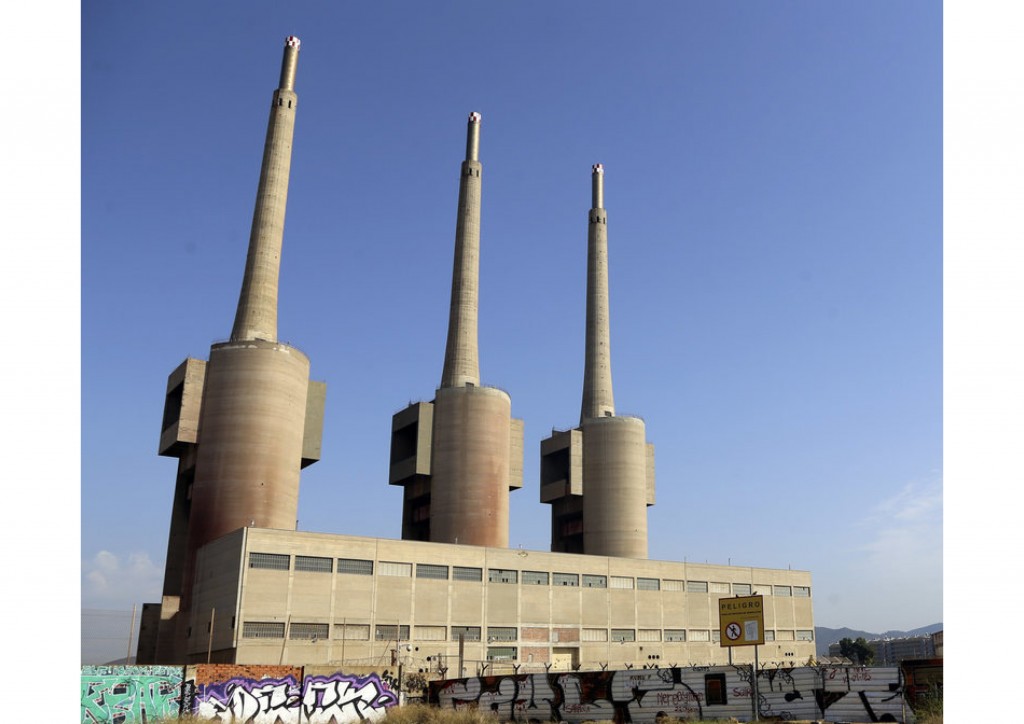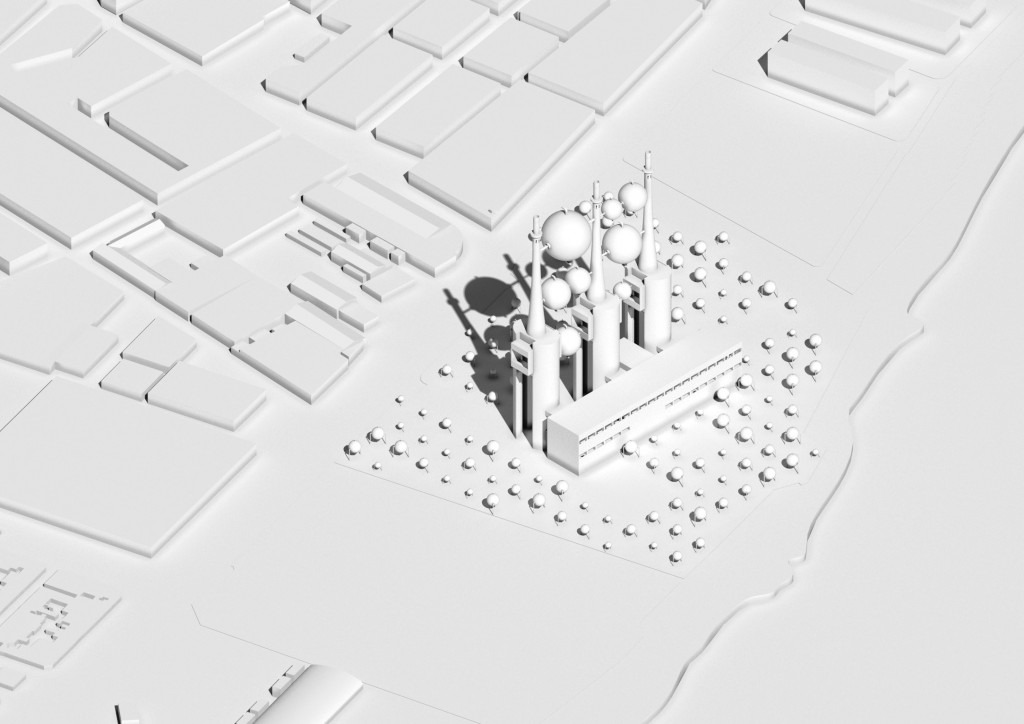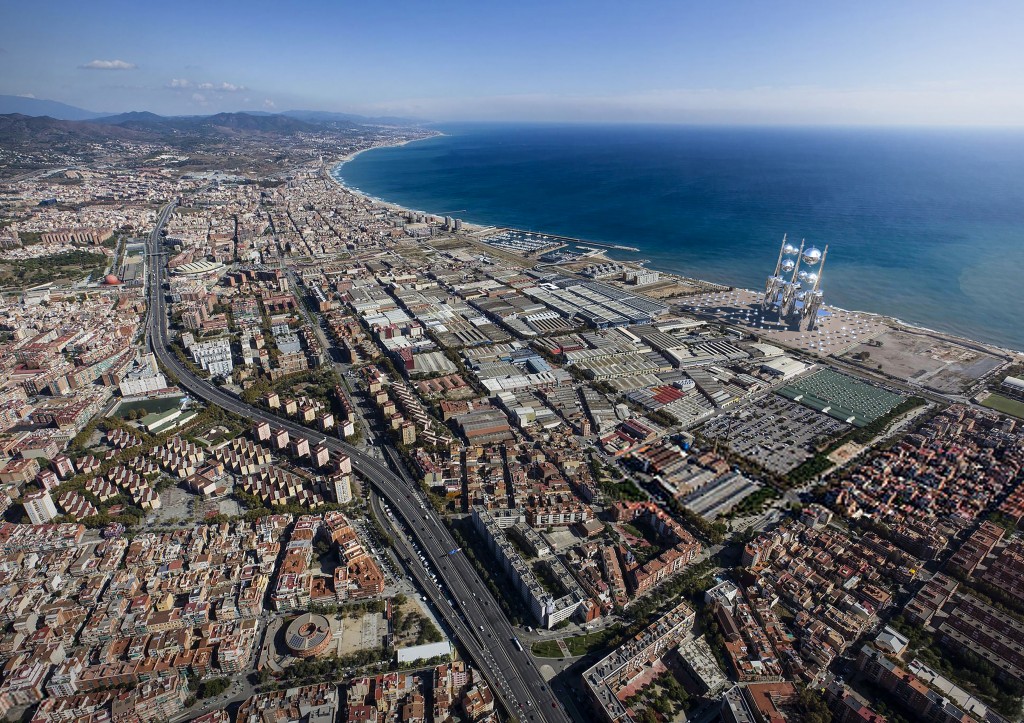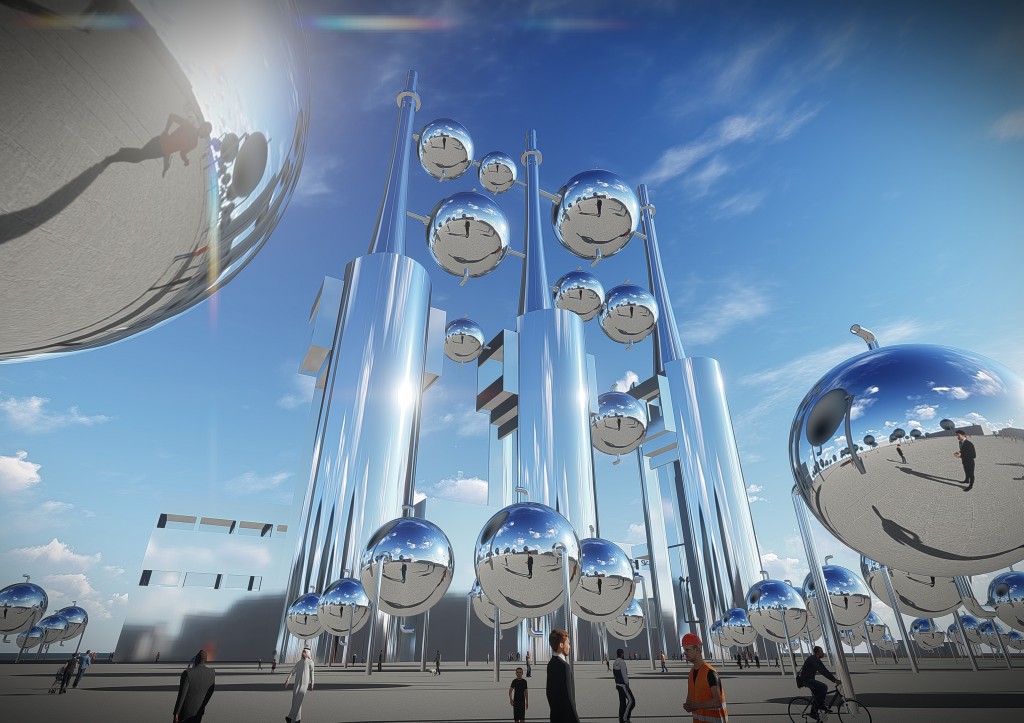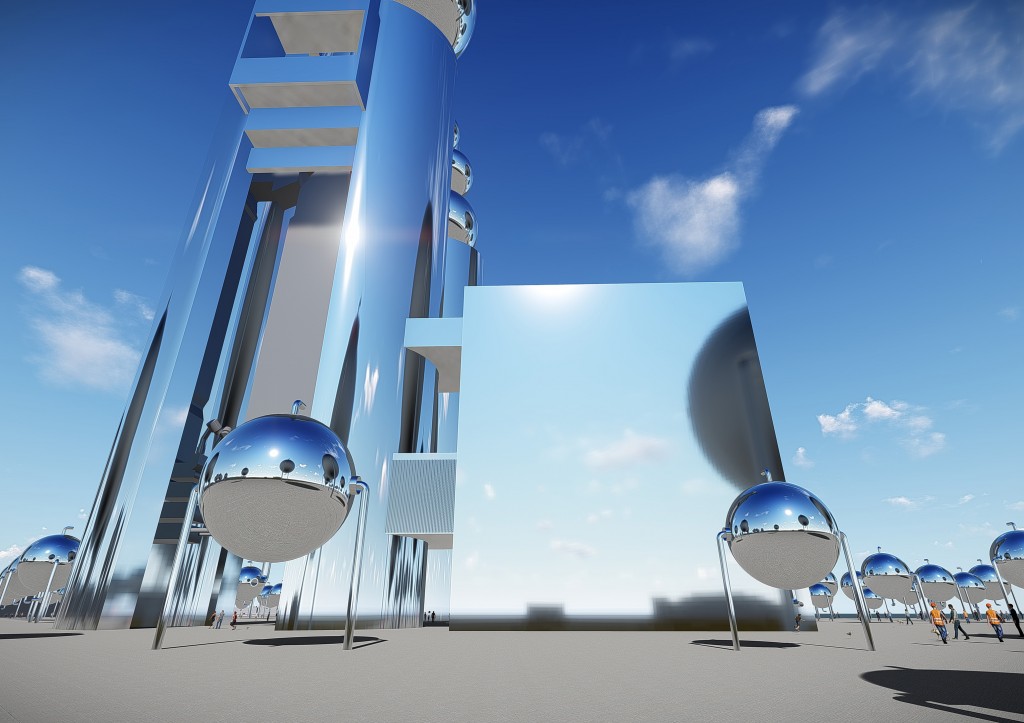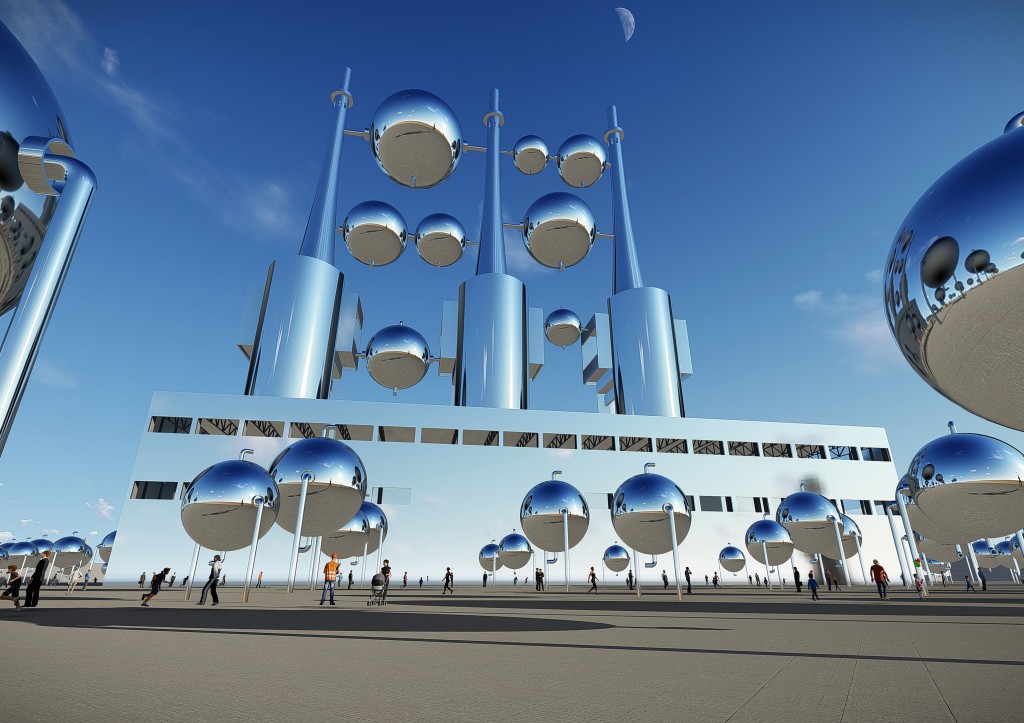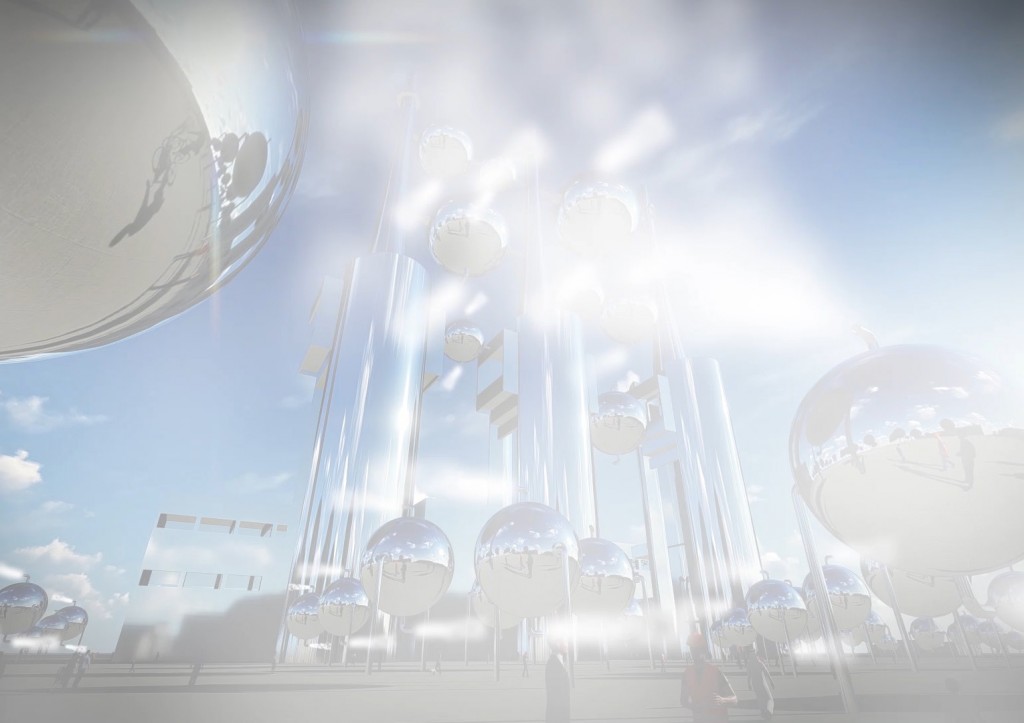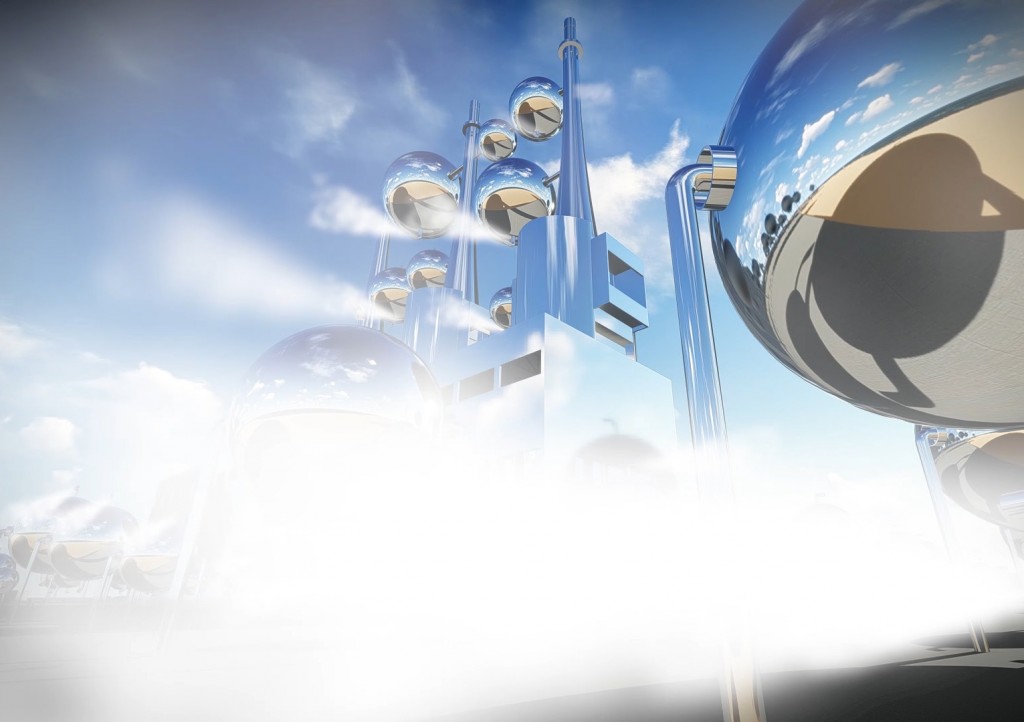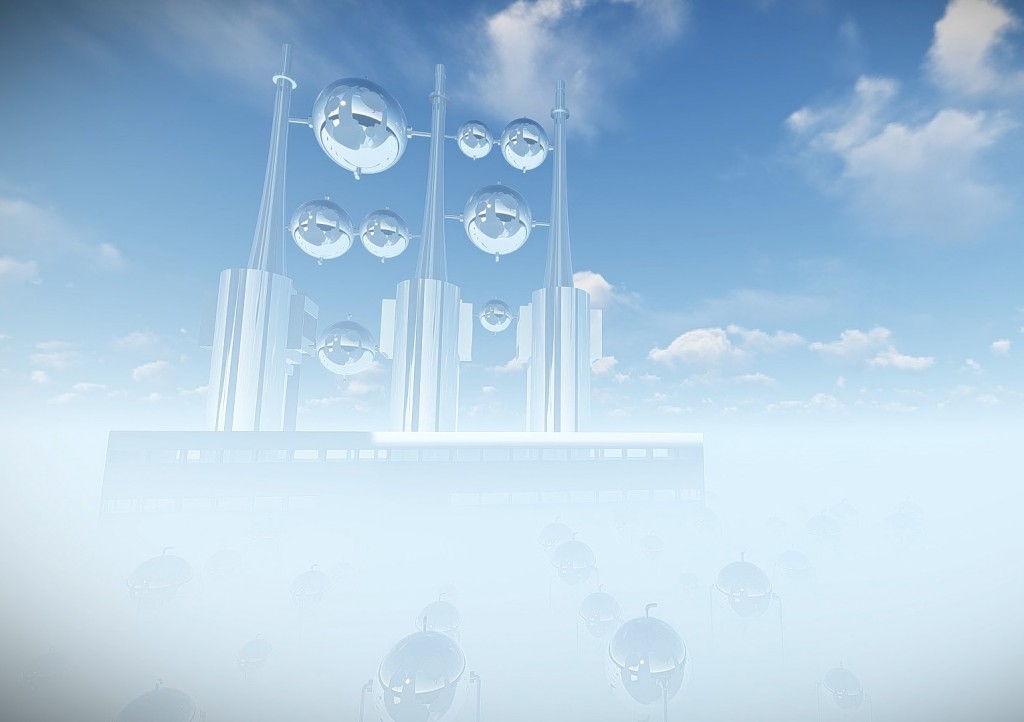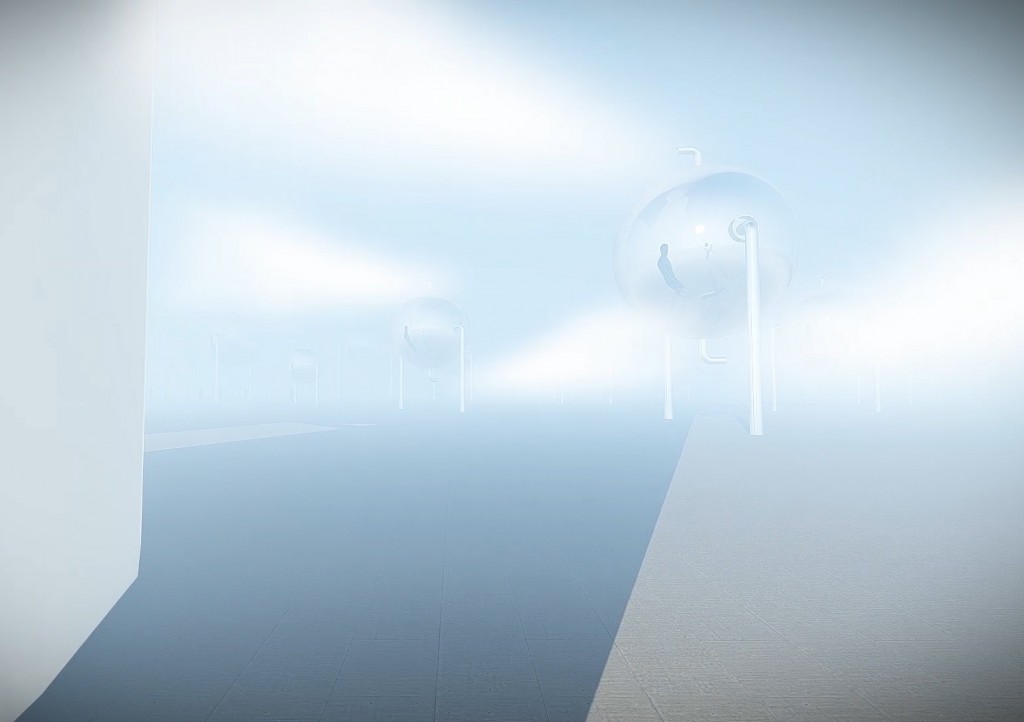THERMODYNAMIC INFRASTRUCTURE IN THE AGE OF GLOBAL WARMING
The Earth, as we know it, is in a state of transition. The human being is no longer the subject that gives meaning to the world and the objects contained in it; at the present time, objects (both animate and inanimate) have a defined identity independent from humans’ perception. According to Timothy Morton, these “objects” can be defined as hyperobjects; they are massively distributed in time and space relative to humans, and they are all related to some other object independent from its origin.
The thesis “Thermodynamic Infrastructure in the Age of Global Warming” first studies one of the most critical hyperobjects: Global Warming. To clarify its action, the concept is deconstructed into a series of categories — technology, literature/thinkers, greenhouse emissions, impact on Earth, and environmental measures — that examine its origin, and evolution, concluding that this evolutionary process is irreversible, and there needs to be a shift of paradigm. After this preliminary research, the proposed thesis presents, on one hand, a meteorological architecture entity that incorporates two existing systems, but by reinterpreting and re configuring its use, it creates new climatic variations that humans did
not acknowledge before. On the other hand, it presents as a critique to the banality with which sustainable architecture is being developed.
The project introduces a coal-powered thermodynamic system, based on a Rankine cycle, that uses seawater as an input, exploring future climatological spaces. It incorporates a series of radial steam engines interconnected by a structural matrix of pipes that, when powered, recreate global warming’s effect on Earth. It produces a cloud of hot steam or “architecture of atmosphere” that interrupts the limits between the mirrored morphology and its surrounding, while progressively
distorting the atmospheric conditions (increase in humidity, pressure, and temperature) of the site and the sensorial experience (sight, hearing, taste, smell, touch) of the user. The result is a hybrid performing system that combines global warming temperature increase with different technological thermodynamic mechanisms to show how the world would look like if it was designed according to the laws of thermodynamics and global warming.
The proposed thesis looks to make contributions in the domains of knowledge by analyzing global warming in the condition of Hyperobject. According to Timothy Morton, member of the object-oriented philosophy movement, hyperobjects are objects massively distributed in time and space relative to humans; they are all related to some other entity, whether or not they are directly manufactured by humans. He defines the main characteristics of hyperobjects, stating that these “are, which means that they ‘stick’ to beings that are involved with them. They are non-local; in other words, any ‘local manifestation’ of a hyperobject is not directly the hyperobject. They involve profoundly different temporalities than the human-scale ones we are used to. In particular, some very large hyperobjects, such as planets, have genuinely Gaussian temporality: they generate space-time vortices,
due to general relativity. Hyperobjects occupy a high-dimensional phase space that results in their being invisible to humans for stretches of time. And they exhibit their effects inter-objectively; that is, they can
be detected in a space that consists of interrelationships between aesthetic properties of objects.”
Timothy Morton considers global warming as the prime example to identify hyperobjects. But what do we understand by Global Warming? According to the Oxford Dictionary, it can be interpreted as a progressive increase in the comprehensive temperature of the earth´s atmosphere due to the “greenhouse effect” caused by increased levels of some gases. These gases, including water vapor (H2O), carbon dioxide (CO2), methane (CH4), nitrous oxide (N2O), ozone (O3), chlorofluorocarbon (CFC), and hydrofluorocarbon (HCFC, HFC), allow sunlight to pass through the atmosphere where it is absorbed by the earth´s surface. The earth´s surface then radiates it back to space in the form of heat; but part
of the heat gets trapped in the atmosphere because of the presence of the gases.
Global warming presents some characteristics that define Morton´s idea of hyperobject. It is viscous in the sense that it “burns the skin on the back of my neck, making me itch with physical discomfort and inner anxiety.” This is evidence that global warming affects all beings involved with it. It is also non-local, meaning it is not visible to humans, if not is visible as a collusion between objects affected by it. “When you feel raindrops, you are experiencing climate, in some sense. In particular you are experiencing the climate change known as global warming. But you are never directly experiencing global warming as such.” It is massively distributed in time and space (temporal undulation) in ways that bewilder humans beings, and makes interacting with them complicated and mysterious. It is phased; we can only see pieces of it at a time because of its trans-dimensional quality. “We only see pieces of them at once, like a tsunami or a case of radiation sickness. Less than adequate perception of higher dimensions of structure, which is where the hyperobjects live.” In order to see global warming, humans would have to occupy a trans-dimensional space to see it “unfolding explicitly”. Finally, it is inter objective. This means it is formed by relations between several objects. Hyperobjects leave footprints; earthquakes can be considered footprints of global warming. They originate because of a variation in oceanic temperature, which change the pressure on Earth’s crust and provoke landslides, liquefaction, and/or tsunamis. As mentioned before, Global Warming is the result of a process by which
radiation from the Earth´s atmosphere heats the crust. It is produced by human activities, and this heat excess impacts the planet Earth in different ways:
• Sea Level Rise: increased by 4 mm per year. The rate in the last two
decades is nearly double that of the last century.
• Actual Temperature: increased by 1ºC since the Industrial Revolution.
Most of the warming occurred in the past 35 years, with 16 of the 17
warmest years on record occurring since 20017.
• Shrinking Ice Sheets: Greenland lost 150 to 250 cubic kilometers
(36 to 60 cubic miles) of ice per year between 2002 and 2006, while
Antarctica lost about 152 cubic kilometers (36 cubic miles) of ice
between 2002 and 20058.
• Ocean Acidification: acidity of surface ocean waters has increased
by about 30 percent since the Industrial Revolution (the amount
of carbon dioxide absorbed by the upper layer
GLOBAL WARMING AS A HYPEROBJECT
The analysis of global warming as a hyperobject and its development throughout time looks to make contributions in the domain of knowledge regarding different aspects of climate change and the use of technology throughout time. There is a main intention to analyze global warming as a progressive increase in the comprehensive temperature of the Earth’s atmosphere due to the “greenhouse effect” caused by an increased level of certain gases.
In order to clarify the idea of global warming, the concept is deconstructed into a series of categories that explain its origin, evolution, and possible future scenarios. These categories are presented as: Technology, Literature (thinkers), Greenhouse Emissions, Impact on Earth (human and natural), Films, and Environmental Measures.
After deeply analyzing global warming in an “average temperature scale rise” condition, and from a theoretical approach, we acknowledge that it had a major increase from the Industrial Revolution until present. It is produced by human activities, and this heat excess impacts the planet Earth in different ways: sea level rise, increase in the Earth´s temperature, and ocean acidification. During this period, technology evolved with the need to adapt to the consumer demand of population growth. But despite various attempts to reduce or revert the conditions, global warming is going to continue increasing. Current evidence indicates that there are no possibilities to maintain nowadays conditions, and human beings will have to adapt to reality. This position opposes to the concept of climate resilience where a system has the capacity of responding to a disturbance by resisting damage, and returning to equilibrium. Nowadays, ecological awareness is increasing and human beings are looking for strategies to reduce the global warming impact. But resilience as we know it cannot be used as a tool of design anymore, if not humans need to shift the way of thinking. Sustainable architecture is being promoted as a means of reducing this impact. These projects simulate an effect of meteorological modification but in reality they are not solving any issue. They are do-goodism 19 proposals without any aesthetic value
Instead of using nature as a design strategy to revert global warming, we need to use technology and incorporate it as a means of design and inhabit these new environments; this technology needs to be used as a tool to replicate nature and its conditions, and not as a resilient tool.
What would happen if instead of using architecture as a tool to decelerate an inevitable evolutionary process, the logic is reversed and global warming is used as an element of design? Furthermore, what if global warming becomes the trigger of an architectural project? Can thermodynamics be used in combination with the fundamentals of global warming to unveil a new reality?
THERMODYNAMIC SYSTEMS – CASE STUDIES
Described in detail in Heron´s writing Pneumatica, the aeolipile is a radial steam engine that produces torque when the water container is heated. It is considered to be one of the first “steam engines” to be invented in history.
The machine consists of a main hollow rotating sphere with two curved nozzles attached to it, a boiler/ water container, two copper bent tubes attached to the container´s lid that act as pivots for the sphere, and a heat source located under the boiler. 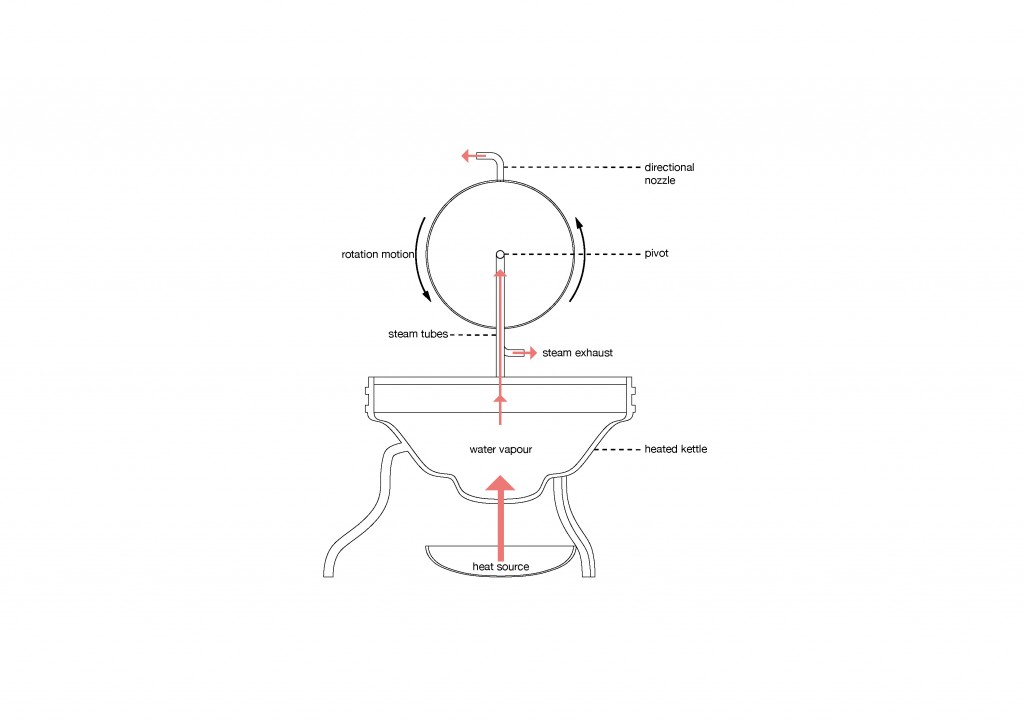
In the section 50 of his book Pneumatica, Heron explains the process of assembly of the aeolipile model. “PLACE a cauldron over a fire: a ball shall revolve on a pivot. A fire is lighted under a cauldron, A B, (Figure 8), containing water, and covered at the mouth by the lid C D; with this the bent tube E F G communicates, the extremity of the tube being fitted into a hollow ball, H K. Opposite to the extremity G place a pivot, L M, resting on the lid C D; and let the ball contain two bent pipes, communicating with it at the opposite extremities of a diameter, and bent in opposite directions, the bends being at right angles and across the lines F G, L M. As the cauldron gets hot it will be found that the steam, entering the ball through E F G, passes out through the bent tubes towards the lid, and causes the ball to revolve, as in the case of the dancing figures.”
When the water contained in the boiler is heated, it pressurizes and the resulting steam rises through the bent tubes up to the sphere. The steam, as a consequence, is expelled through the curved nozzles generating thrust because of Newton´s second and third laws of motion; the nozzles, pointing in opposite directions, generate forces in different lines of action.
This results in a rotational force or torque, causing the sphere to spin about its axis. While the rotational speed (rpm) increases, the accelerating torque is consumed. After the torque is totally consumed, the system achieves a steady state speed.
Watt´s Rotative Beam Engine.
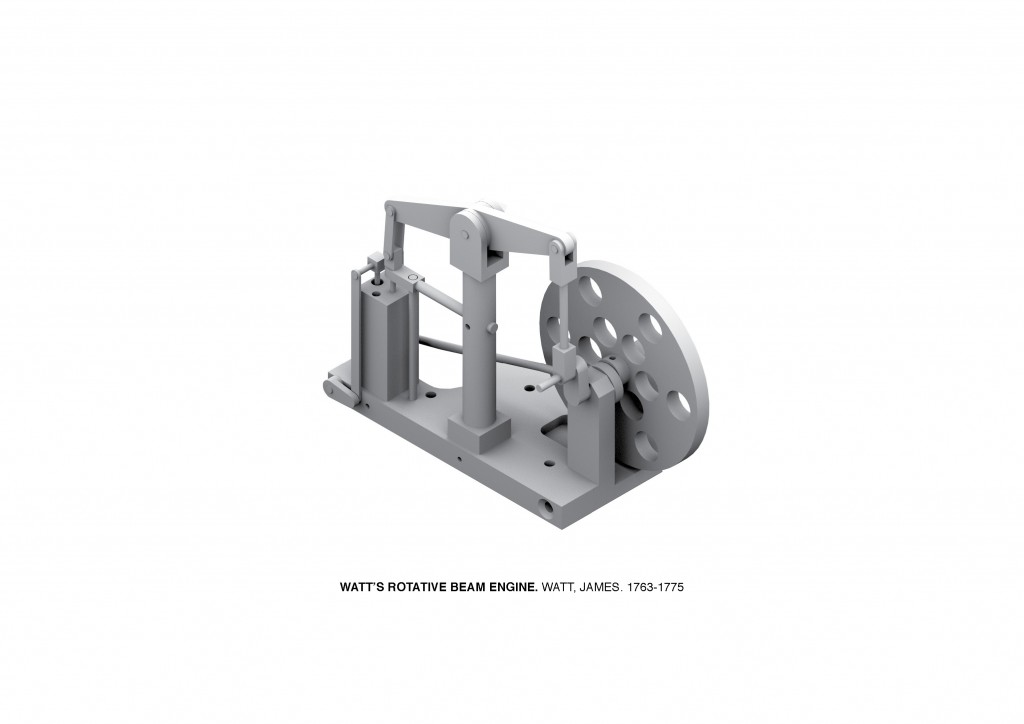 Invented and improved by James Watt and Matthew Boulton between the years of 1763 to 1775, this machine is considered the first type of steam engine to make use of a separate condenser. The first models used the same principle as Thomas Newcomen´s atmospheric engine (Figure 14). These used steam just above atmospheric pressure to generate a vacuum below the piston. The difference between the atmospheric pressure and vacuum, above and below the piston respectively, drove it up and down the cylinder. These engines were mainly used for draining mines.
Invented and improved by James Watt and Matthew Boulton between the years of 1763 to 1775, this machine is considered the first type of steam engine to make use of a separate condenser. The first models used the same principle as Thomas Newcomen´s atmospheric engine (Figure 14). These used steam just above atmospheric pressure to generate a vacuum below the piston. The difference between the atmospheric pressure and vacuum, above and below the piston respectively, drove it up and down the cylinder. These engines were mainly used for draining mines.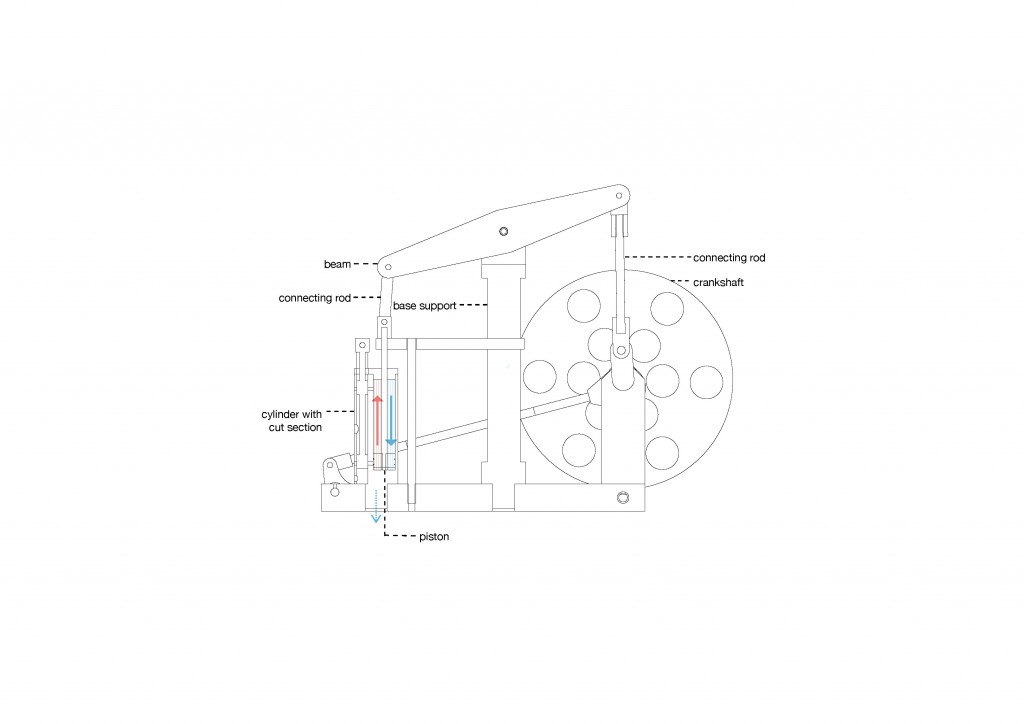
Watt´s improvement came years after the first engine type; first, he developed the concept of parallel motion (Figure 16) which consists of a jointed link to reproduce motion parallel to itself. Then, he incorporated this technology to his machine, creating the rotative beam engine.
In this type of steam engine, the piston is mounted vertically and the piston rod operates the beam as previously. A connecting rod, attached to the opposite side of the beam, drives a flywheel instead of a pump rod. In the beginning, Watt used the sun and planet gear but later he replaced this by a crank. The flywheel, once in motion, maintained a constant power by its momentum. At this point, a drive belt and gears could be attached next to the flywheel to drive different types of machinery.
Because of the need of certain machines to operate at a constant speed, Watt “linked a steam regulator valve to a centrifugal governor (Figure 16) which he adapted from those used to automatically control the speed of windmills.”
Stirling Engine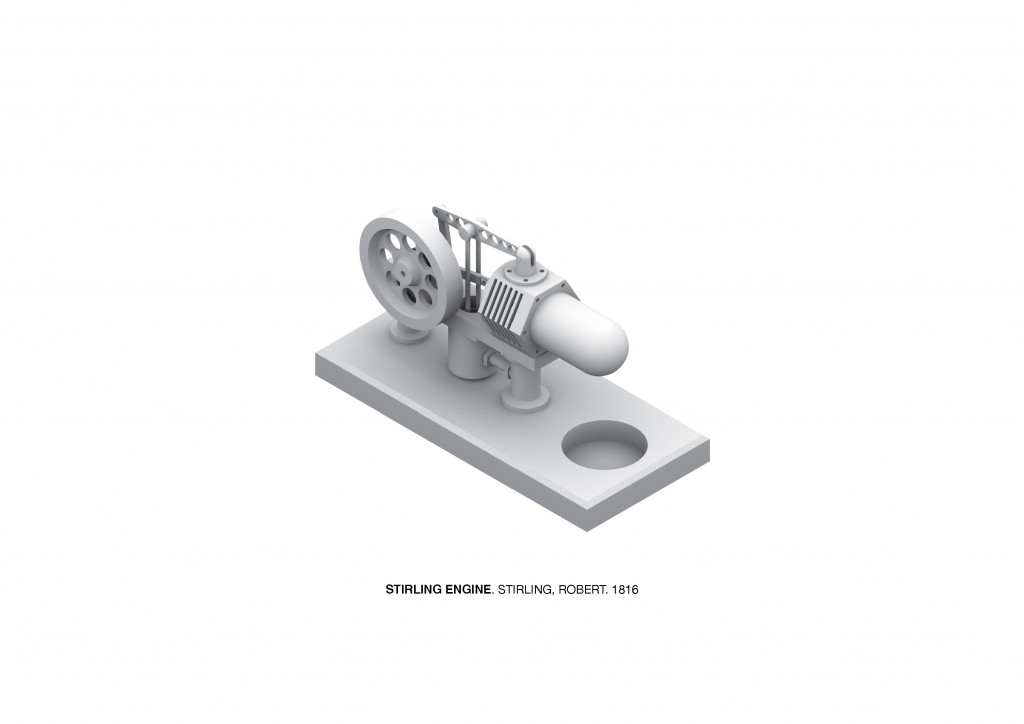 Invented and patented in 1816 as an alternative to the steam engine, this type of heat engine works by cyclic compression and expansion of a fluid at different temperatures, resulting in a net conversion of heat energy to mechanical work. This closed-loop system drives two pistons which cause the shaft to rotate and encloses a working fluid permanently inside. This engine is based on the Stirling Cycle. Figure 7 shows the four main processes which overlap between transitions.
Invented and patented in 1816 as an alternative to the steam engine, this type of heat engine works by cyclic compression and expansion of a fluid at different temperatures, resulting in a net conversion of heat energy to mechanical work. This closed-loop system drives two pistons which cause the shaft to rotate and encloses a working fluid permanently inside. This engine is based on the Stirling Cycle. Figure 7 shows the four main processes which overlap between transitions. 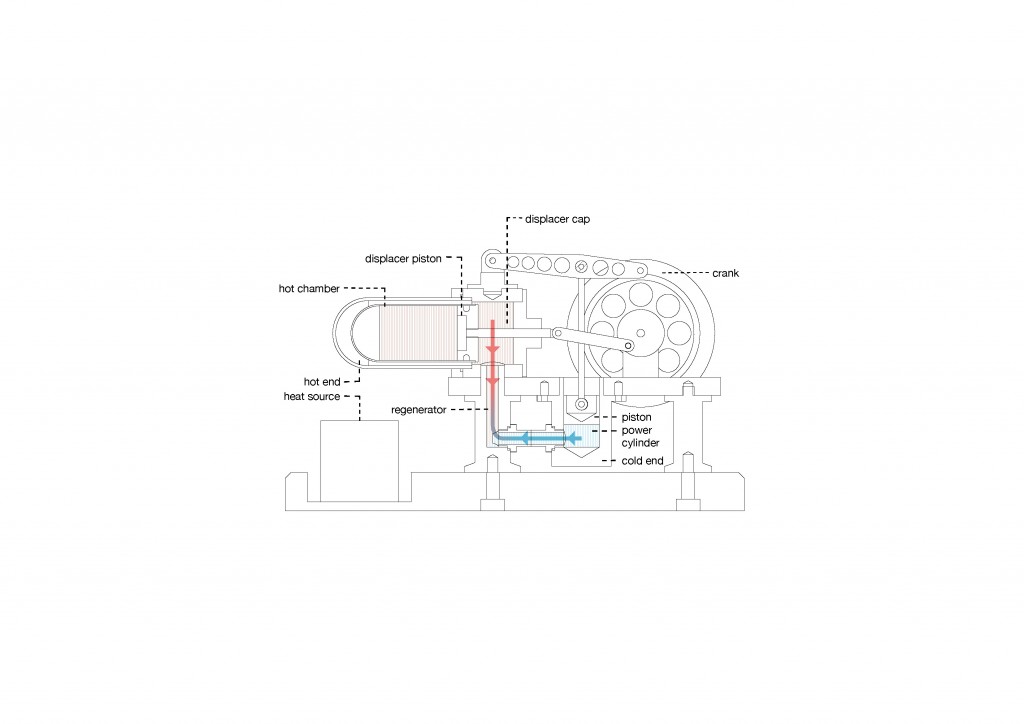 The engine has four main positions that determine the movement in a closed loop:
The engine has four main positions that determine the movement in a closed loop:
1 – When the connecting rod is in this position, most part of the working fluid is in contact with the hot chamber, heating and expanding; the fluid is at its maximum temperature. This causes the fluid to push the hot piston to the bottom of its travel in the cylinder. The expansion continues in the cold chamber, extracting more work from the hot gas.
2 – The fluid is now at its maximum volume. The hot cylinder piston begins to move most of the fluid into the cold cylinder, where it cools and pressure drops.
3 – Almost of all the gas is inside the cold chamber and cooling continues; the fluid is at its minimum temperature. The cold piston compresses the remaining part of the gas, powered by flywheel momentum.
4 – The fluid reaches its minimum volume, and it expands in the hot chamber where it is heated once again , driving the hot piston in its power stroke.
This thermodynamic cycle transfers heat and work in and out of the system, varying the pressure, temperature, and volume of the fluid. After a full cycle, the system returns to its initial state. This thermodynamic cycle is known as Stirling Cycle.
Cross-flow Closed Circuit Cooling Tower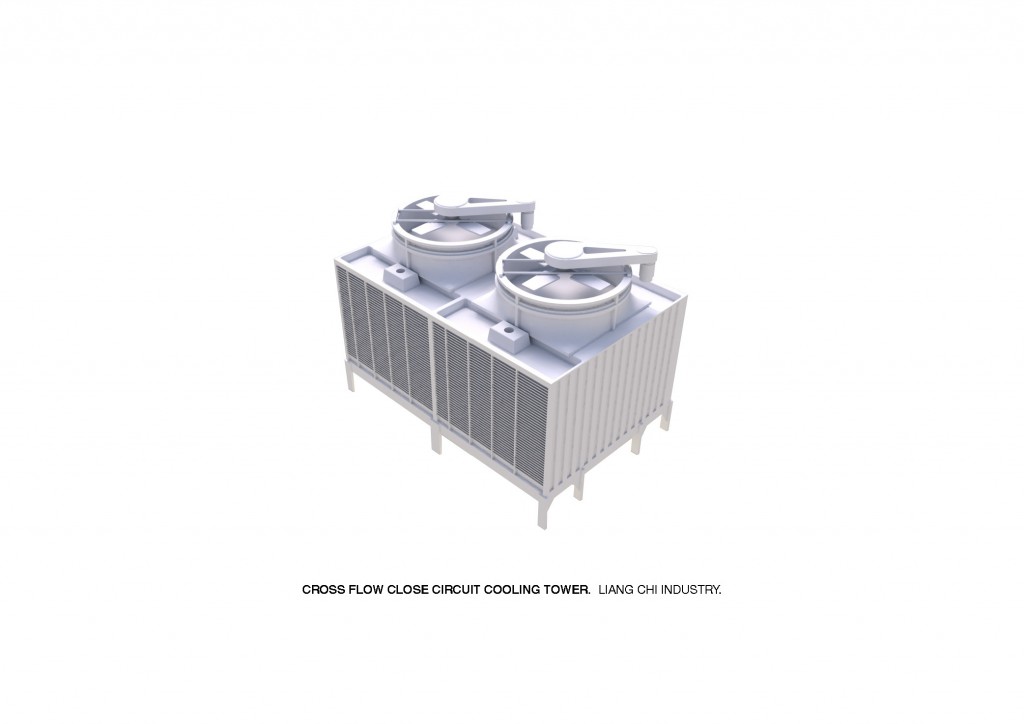 Cooling towers are specifically designed and optimized heat exchangers used to lower temperatures of fluid which has been overheated by industrial processes. Cross flow closed circuit towers work with the basic principles of cooling towers, but have two different fluid loops. The first one is an internal circuit in which the overheated fluid circulates through heat exchange coils, or cooling coils. And the second one is an external circuit which cools the coils externally with spray fluid by incorporating sprinklers, and air flowing from the exterior to the interior of the machine.
Cooling towers are specifically designed and optimized heat exchangers used to lower temperatures of fluid which has been overheated by industrial processes. Cross flow closed circuit towers work with the basic principles of cooling towers, but have two different fluid loops. The first one is an internal circuit in which the overheated fluid circulates through heat exchange coils, or cooling coils. And the second one is an external circuit which cools the coils externally with spray fluid by incorporating sprinklers, and air flowing from the exterior to the interior of the machine.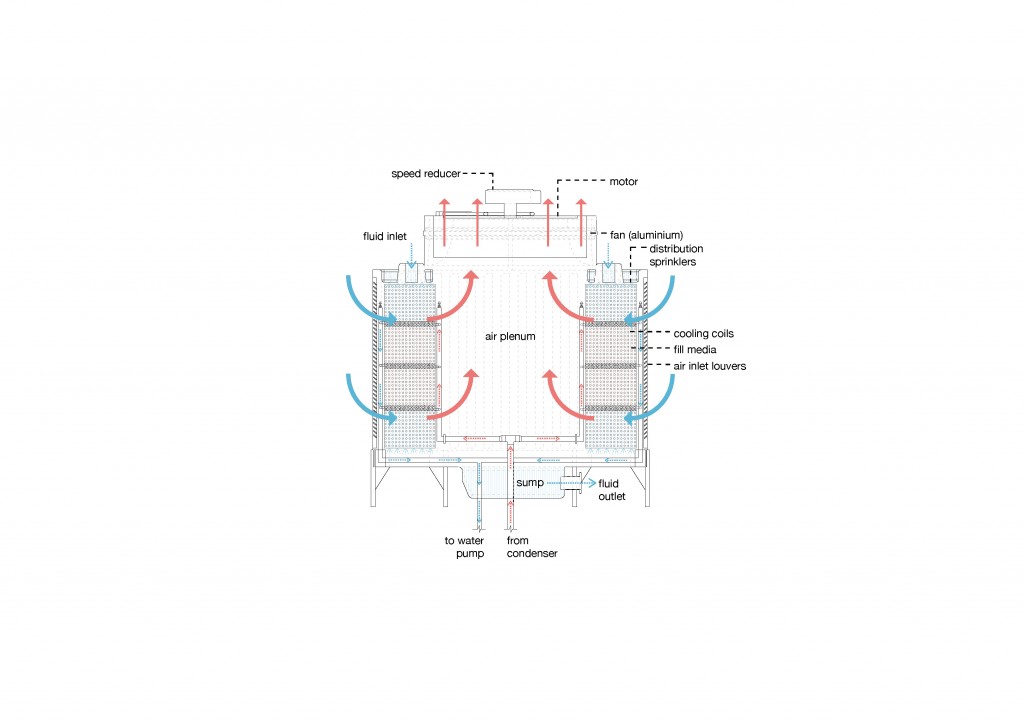 As shown in Figure 30, the overheated fluid is condensed and piped through the cooling coils in a closed-loop that isolates the fluid from the outside air to keep it free from contamination. Meanwhile, the external circuit pumps cooling fluid into the distribution basins at the top of the tower, and disperses it evenly with distribution nozzles onto the cooling coils and fill media below, ensuring maximum heat transfer efficiency and avoiding back splash. As the fluid cools the coils, it receives some heat transfer, and therefore must be simultaneously cooled over the fill media with external air.
As shown in Figure 30, the overheated fluid is condensed and piped through the cooling coils in a closed-loop that isolates the fluid from the outside air to keep it free from contamination. Meanwhile, the external circuit pumps cooling fluid into the distribution basins at the top of the tower, and disperses it evenly with distribution nozzles onto the cooling coils and fill media below, ensuring maximum heat transfer efficiency and avoiding back splash. As the fluid cools the coils, it receives some heat transfer, and therefore must be simultaneously cooled over the fill media with external air.
The uniqueness of cross flow cooling is that the cooling fluid falls vertically via gravity through the cooling coils and fill media, while air crosses the coils horizontally, meaning the air is exempted from passing through the distribution system.
On the interior, the air plenum houses a fan that draws air through the external system. It also releases the vapor that forms as a result of the heat transfer from the coils to the spray fluid.
Below, the sump collects the external circuit’s cooled fluid which is recycled to the distribution nozzles to repeat the cooling process. This makes the machine work with a closed loop system.
Deterritorialized Milieus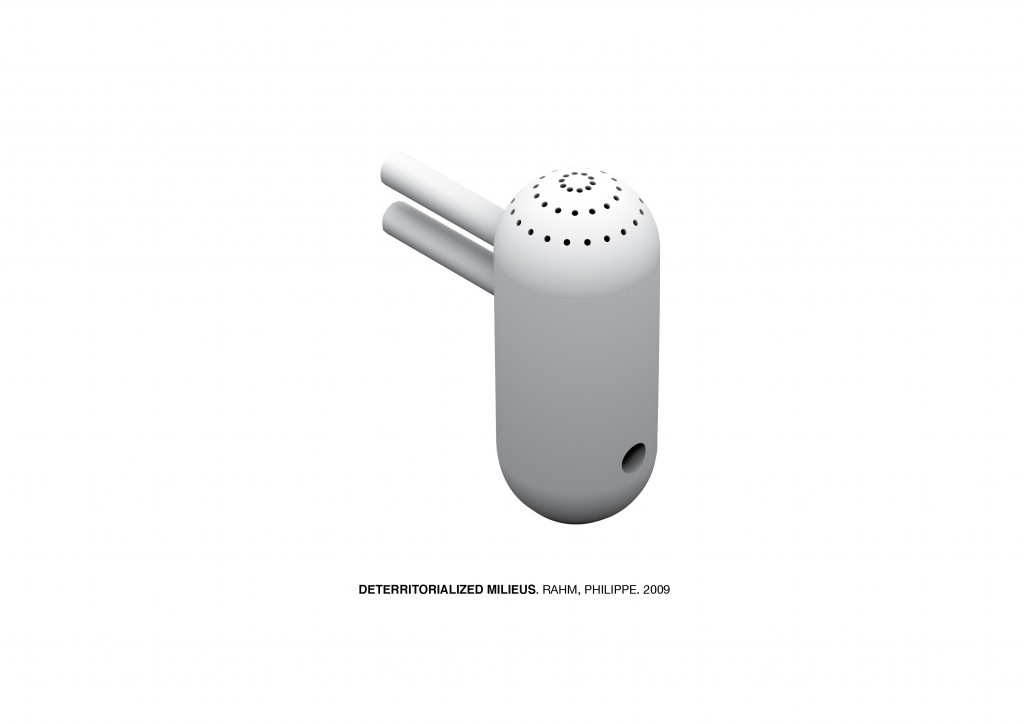 Deterritorialized milieus is a study of contemporary furnishing and lifestyles to reintroduce the concept of terroir and local climate “in the constrains of the local apparatuses”. The project reproduces the geology and atmosphere or Paris both physically and chemically before the emergence of industrial pollution in the 19th Century.
Deterritorialized milieus is a study of contemporary furnishing and lifestyles to reintroduce the concept of terroir and local climate “in the constrains of the local apparatuses”. The project reproduces the geology and atmosphere or Paris both physically and chemically before the emergence of industrial pollution in the 19th Century.
“As such it represents a process that is simultaneously nostalgic and prospective, a scale-model reconstitution of the geology surrounding Paris and of its atmosphere in pre-modern times, with its limestone strata and semi-oceanic climate, prevalent winds blowing mainly from the Atlantic, the south-west, sweeping over the eroding limestone strata of Normandy and the white chalk bedrock of the Loire valley country, becoming impregnated with their mineral and the scents of oak and chestnut forests typical of the soils of these regions”.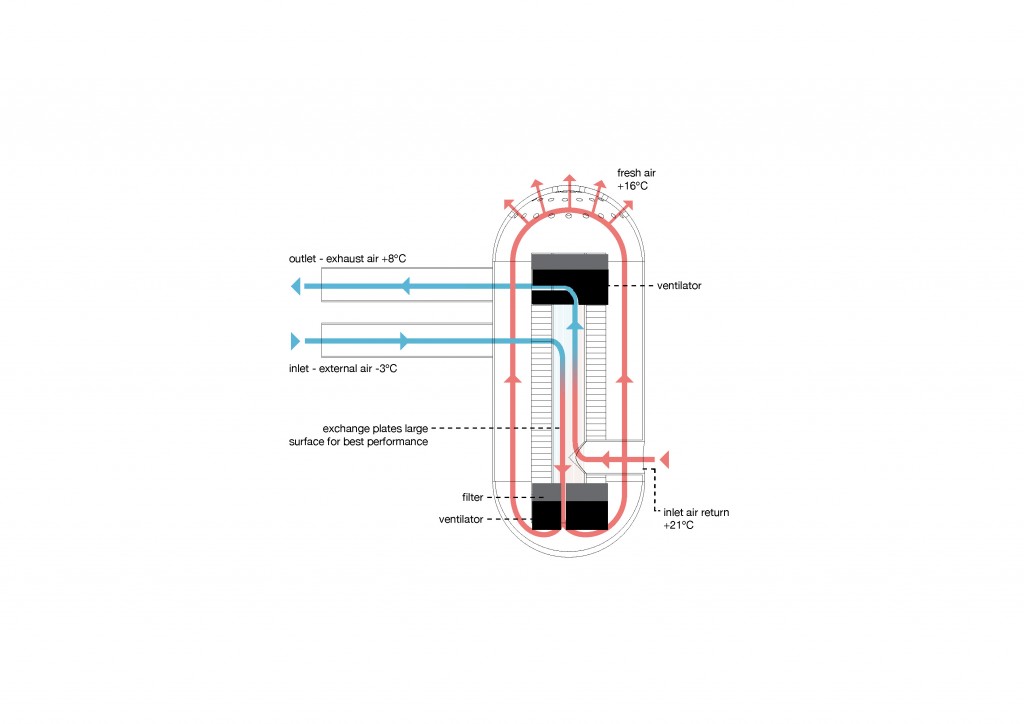 The project presents three types of furniture which recreate a kind of chemical bond with the Parisian context and look to reduce the greenhouse gas emissions. At first it presents as a system of radiators made up of calcareous stones from the grounds of Parisian soils whose position in space generates a typical mini-wind of the west. Then, it is a double-flow air exchanger which stimulates air renovation in the interior space by regulating ambient humidity using different typical wood species from forests surrounding Paris. The proposal also incorporates a lamp whose switch allows a controlled simulation of light during any hour of a Parisian spring day. As a result of the temperature manipulation in the room, Rahm places three chairs at various heights to benefit from this variation.
The project presents three types of furniture which recreate a kind of chemical bond with the Parisian context and look to reduce the greenhouse gas emissions. At first it presents as a system of radiators made up of calcareous stones from the grounds of Parisian soils whose position in space generates a typical mini-wind of the west. Then, it is a double-flow air exchanger which stimulates air renovation in the interior space by regulating ambient humidity using different typical wood species from forests surrounding Paris. The proposal also incorporates a lamp whose switch allows a controlled simulation of light during any hour of a Parisian spring day. As a result of the temperature manipulation in the room, Rahm places three chairs at various heights to benefit from this variation.
Double-flow Air Exchanger
This interior design prototype is a double-flow air exchanger that works to control ambient moisture using wood species local to Parisian forests. There are two inputs: one indoor air return pipe which directs air into the core at 21ºC, and one external pipe which directs exterior air into the core at a low temperature (-3ºC). Here, the airs contact and mix, and any humidity is absorbed by the dry wood of the core. The warmer air rises and exits at the exhaust pipe, while the colder air sinks and is filtered and ventilated to the outer core. The outer wood fragrances the fresh air in the outer core, and is released into the ambient environment at 16ºC.
Planet Earth as a Thermodynamic Machine
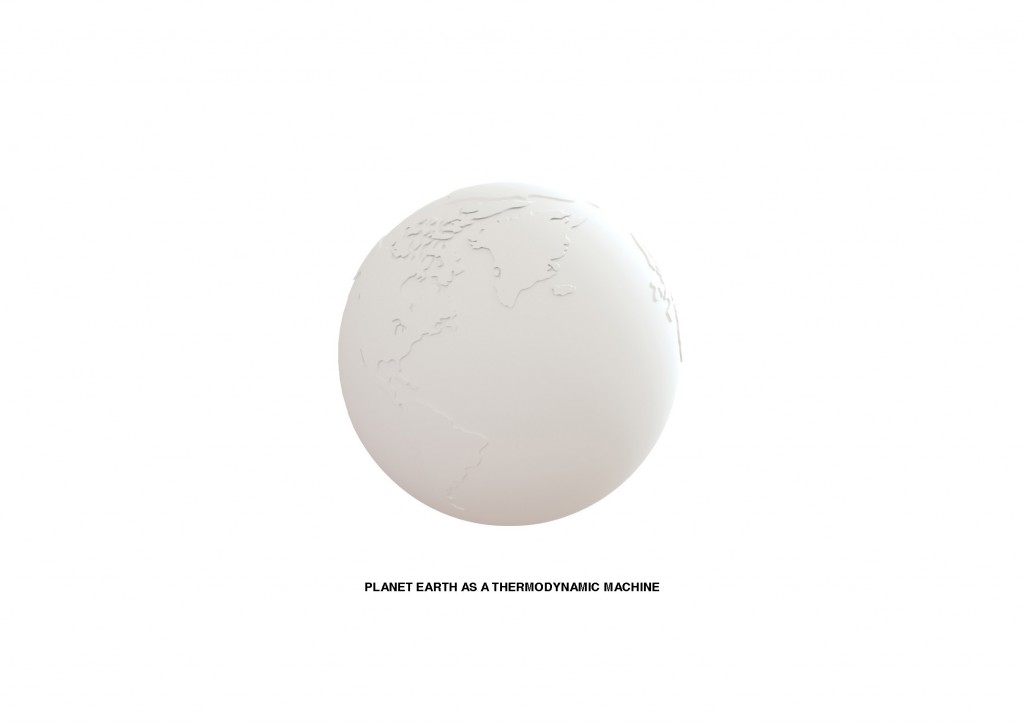 Planet Earth is the biggest thermodynamic system that we know of. Throughout history, the Earth has presented different changes in its state far from thermodynamic equilibrium. When a system is in equilibrium, it tends to prevail in this state with no spontaneous changes in its microscopic properties. The thermodynamic disequilibrium began when life appeared on Earth, and continues with the increase in abundance, complexity, and diversity.
Planet Earth is the biggest thermodynamic system that we know of. Throughout history, the Earth has presented different changes in its state far from thermodynamic equilibrium. When a system is in equilibrium, it tends to prevail in this state with no spontaneous changes in its microscopic properties. The thermodynamic disequilibrium began when life appeared on Earth, and continues with the increase in abundance, complexity, and diversity.
This evolution of life is supported by solar emissions that provide low entropy. The Earth´s surface receives mainly energy from incident sunlight. All of this entropy is emitted back to space as infrared radiation. On the other hand, living organisms are net emitters of entropy; they take in energy on a low entropy form and give it out in a high entropy form.
Earth is also a net emitter of entropy. “The Earth emits into space just as much energy as it absorbs from the Sun (1.2 x 1017 joules per second). However the supply energy (from the white-hot Sun) carries less entropy per joule than the thrown away energy (infrared radiation into space)”. This is what permits it to execute entropy decreasing activities on its surface, and thus support life.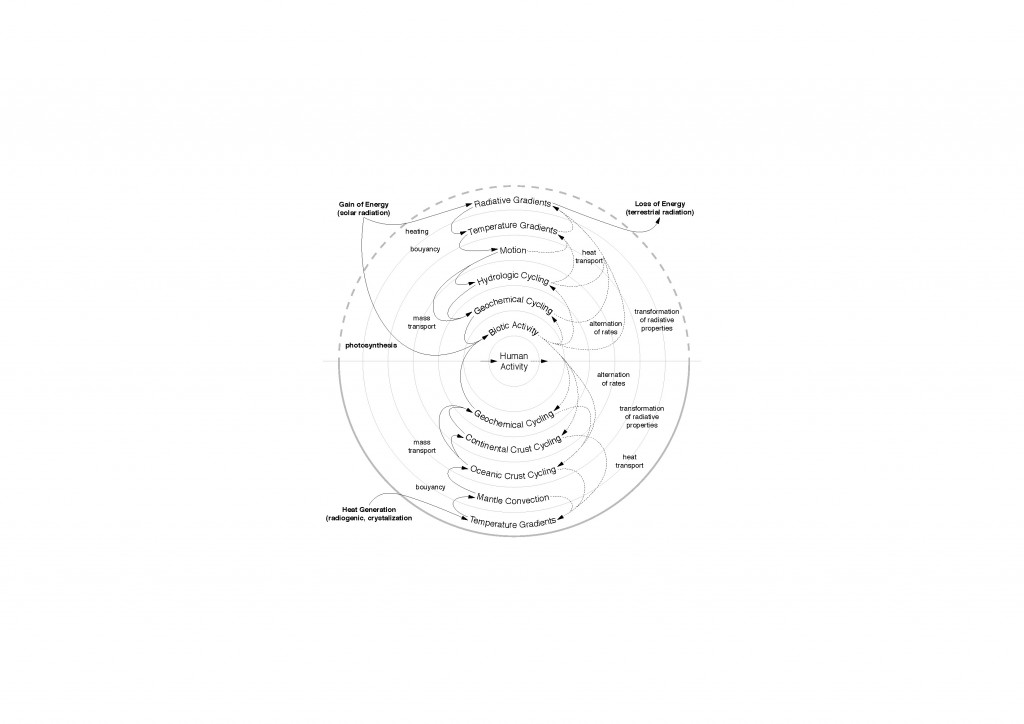
James Lovelock argues that if oxygen would not be recurrently replenished by photosynthesis30, it would react and the atmospheric composition would reach a final state of thermodynamic equilibrium. In the Gaia hypothesis, he states that “the Earth’s atmospheric composition is kept at a dynamically steady state by the presence of life”.
Most gases present in the atmosphere are either produced or processed by living organisms. Some of the gases can result from the photochemical processes that generate considerable amounts of free chemical energy. This idea defines living organisms as being the means to alter certain aspects of Earth´s atmosphere that unbalance its thermodynamic equilibrium. Other gases, such as carbon dioxide, are maintained in the atmosphere.
THERMODYNAMIC INFRASTRUCTURE
The proposed project unfolds as a new type of architectural entity designed by non-human actors. From the study of thermodynamic principles and systems and global warming, the project attempts to adopt and reconfigure elements that exist in this world.
After a thorough analysis of different thermodynamic systems, the project focuses on two main infrastructures: the aeolipile and the thermal power station.
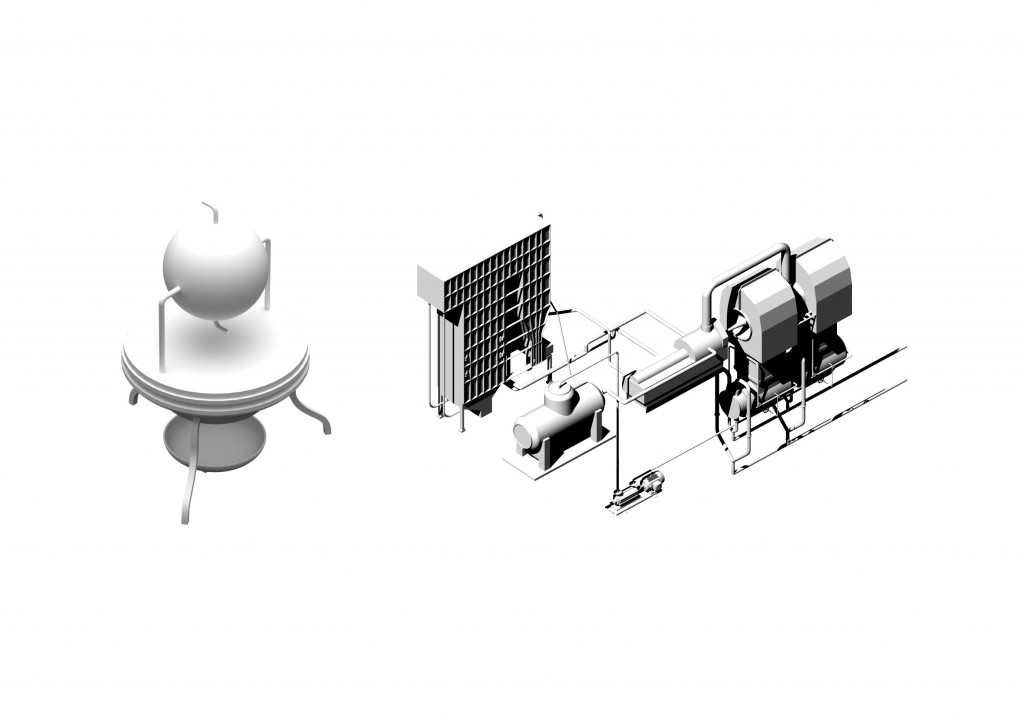 By rearranging and accelerating these processes a new entity emerges, giving access to a previously unknown world. This world holds an unseen genus of architecture that constructs varied meteorological atmospheres.
By rearranging and accelerating these processes a new entity emerges, giving access to a previously unknown world. This world holds an unseen genus of architecture that constructs varied meteorological atmospheres.
THE SITE
The site is selected foremost for its existing infrastructure which lends to the form and function of the proposal. The site in Sant Adria de Besos, Barcelona, Spain, was formerly an active thermal power plant. Its activity ceased in 2011 because of non-compliance with then current environmental standards. As a result, the site in present day presents an obsolete system for the hyperobject to reuse, reinventing its function.
THE MACHINE
The project presents as a meteorological machine that incorporates the principles of thermodynamics to regulate climatic and sensorial parameters (temperature, sound, pressure, humidity, and visibility) in order to construct and manipulate climatic variations.
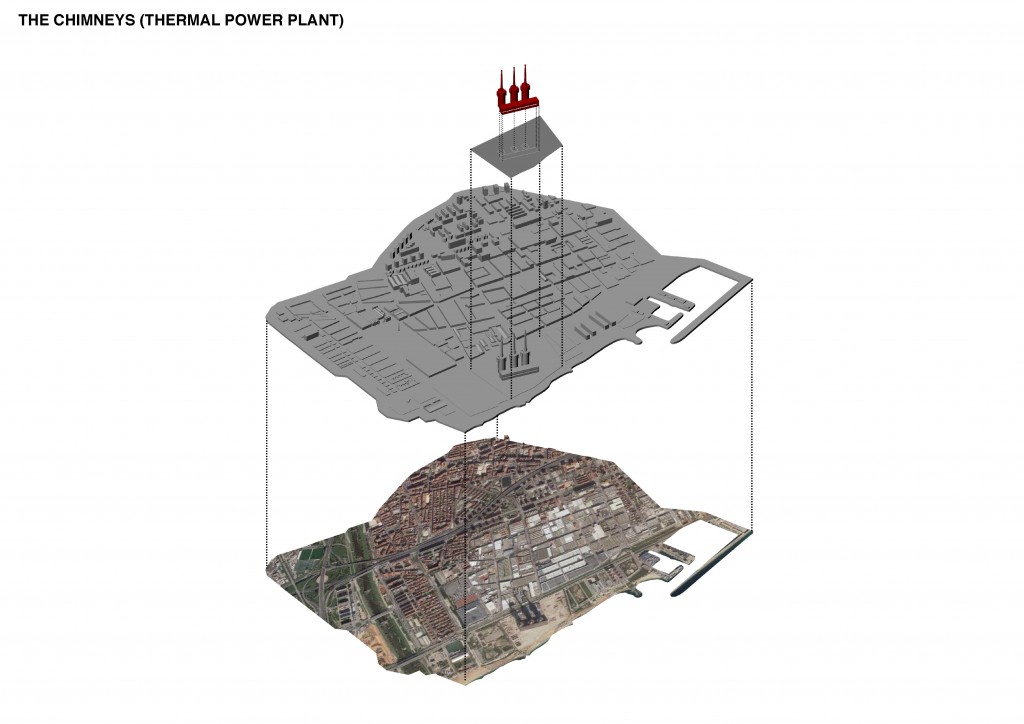 The system is coal-powered and works based on the mechanical principles of thermodynamics, incorporating a modified version of a Rankine cycle to satisfy the necessities of the project as a whole. The project introduces two main parts: the thermal engine which produces saturated steam with specific properties, and the radial steam turbines which are connected to the system, expelling the generated steam and, as a consequence, altering both the macro and micro-climatic parameters of the site.
The system is coal-powered and works based on the mechanical principles of thermodynamics, incorporating a modified version of a Rankine cycle to satisfy the necessities of the project as a whole. The project introduces two main parts: the thermal engine which produces saturated steam with specific properties, and the radial steam turbines which are connected to the system, expelling the generated steam and, as a consequence, altering both the macro and micro-climatic parameters of the site.
After Buckminster Fuller’s manifesto, meteorologists incorporated into architecture the concept of the world as a macro-interior. They assumed the role of reformers, transmitting to the rest of the human beings the necessity of changing their lifestyles. They shaped the basis of the new architecture, giving a predominant role to sustainability.
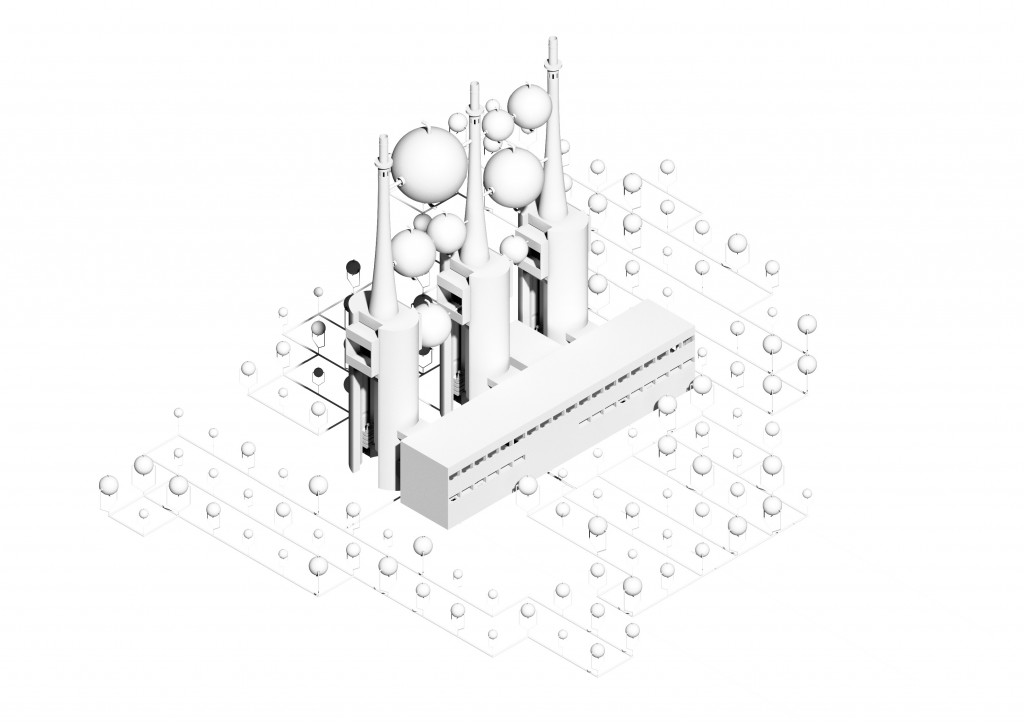 The present thesis approaches architecture not only from an architect’s perspective but also from a meteorologist point of view, incorporating chemical and physical atmospheric elements that go beyond form and function.
The present thesis approaches architecture not only from an architect’s perspective but also from a meteorologist point of view, incorporating chemical and physical atmospheric elements that go beyond form and function. 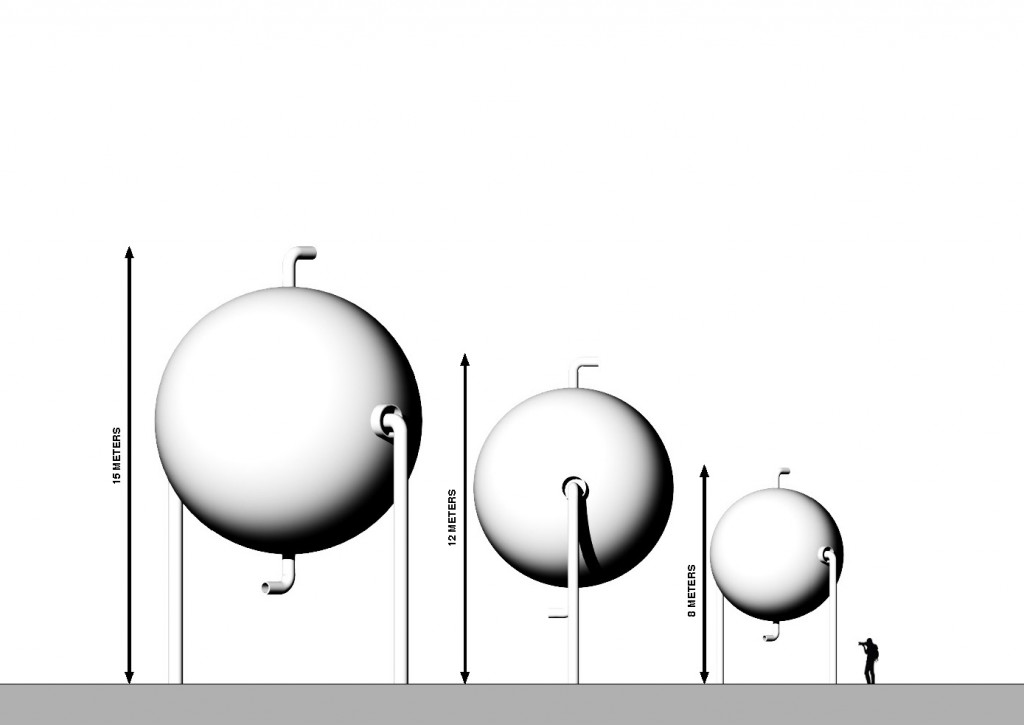
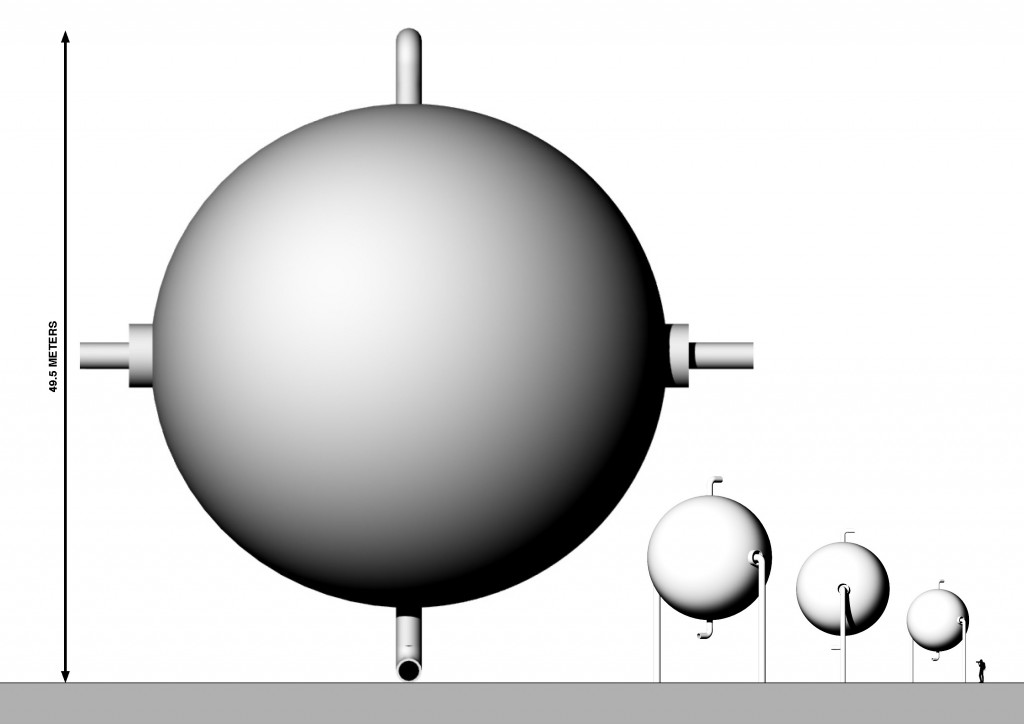
The thermodynamic system generates saturated steam with the following properties:
• Temperature: 99.63°C
• Absolute Pressure: 0.987 atmospheres
• Specific Heat: 2026.7 J/(kg. K)
• Density: 0.59 kg/m³
• Heat Capacity Ratio: 1.33925
• Enthalpy of Steam: 2675 KJ/kg
• Entropy of Steam: 7358.95 J/(kg. K)
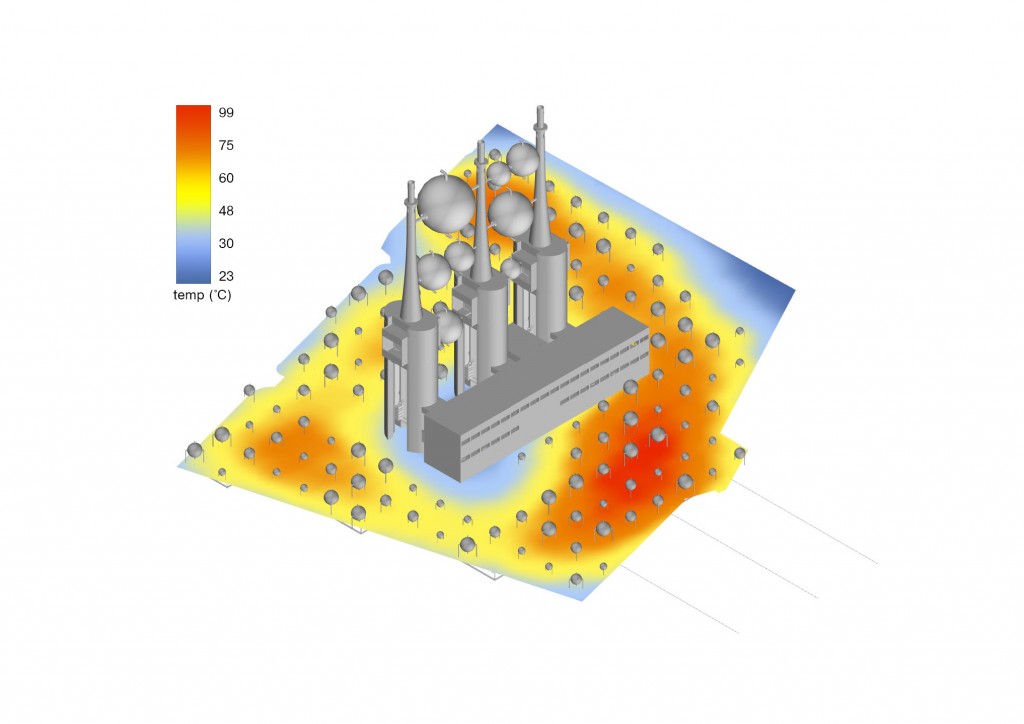 The steam generated by the system travels through the pipes with a velocity of 25m/s to 30m/s, increasing its pressure and exiting through the bent nozzles. Since these nozzles produce opposite forces along different lines of action, the built thrusts combine producing a force of torque, and as a consequence rotate the vessel.
The steam generated by the system travels through the pipes with a velocity of 25m/s to 30m/s, increasing its pressure and exiting through the bent nozzles. Since these nozzles produce opposite forces along different lines of action, the built thrusts combine producing a force of torque, and as a consequence rotate the vessel.
The values considered for the site located in Sant Adria de Besos, Barcelona are:
• Average temperature: 23°C
• Relative annual humidity: 70%
These values, combined with the steam produced by the system, generate 6 different zones with varied levels of temperature, humidity, visibility, and noise levels (Figure 74).
The temperature in each zone is not random; these are temperature values artificially built and manipulated, in order to introduce different sensorial experiences. Since the highest saturated air temperatures a human being can tolerate are 48°C and 35°C for short-term and long-term periods respectively, the proposal “plays” with those values in order to develop heat spaces that establish invisible boundaries and therefore constructing solid areas (zone 1, zone 2, zone 3) which act as boundaries and voids (zone 4, zone 5, zone 6) which serve as circulation. The boundaries are not physically constructed, but rather sensorially defined.
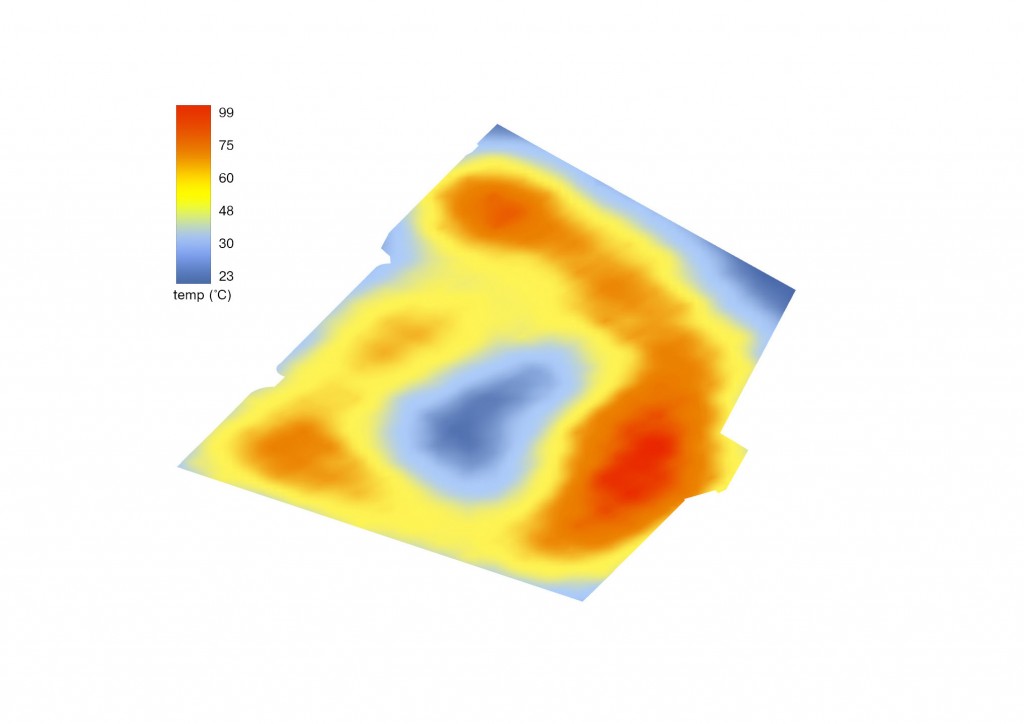 These boundaries dictate the laws of movement inside the project. Since the average temperature is elevated, what is considered an average temperature (23°C) becomes the comfort zone. And the short-term maximum temperature a human can tolerate becomes the new average temperature. This amplifies the human being discomfort, accelerating the perspiration process. The same happens with the humidity, visibility, and noise levels; the higher the temperature in a zone, the higher the other outputs present.
These boundaries dictate the laws of movement inside the project. Since the average temperature is elevated, what is considered an average temperature (23°C) becomes the comfort zone. And the short-term maximum temperature a human can tolerate becomes the new average temperature. This amplifies the human being discomfort, accelerating the perspiration process. The same happens with the humidity, visibility, and noise levels; the higher the temperature in a zone, the higher the other outputs present.
As a result, the project physically performs unveiling a new reality that we didn’t know of. When the system is not active, a matrix of radial steam engines linearly organizes the space. The site presents as an urban park with various steam engines as obstacles. But when the system is at its full performance, it emits various sensory signals that alter both the meteorological conditions and humans perception of space. The machine can manipulate the emission levels, defining three main stages:
When the system is not active, a matrix of radial steam engines linearly organizes the space. The site presents as an urban park with various steam engines as obstacles. But when the system is at its full performance, it emits various sensory signals that alter both the meteorological conditions and humans perception of space. The machine can manipulate the emission levels, defining three main stages:
• Maximum Level
• Medium Level
• Minimum Level
 These levels act in two different scales:
These levels act in two different scales:
Macro-climatic Scale: there is an intention to interrupt the extension of the morphology from the context and show what the creation is capable of. And also to envision how reality would look like if Global Warming became tangible.
Micro-climatic Scale: there is an intention to manipulate meteorological patterns by producing thermodynamic interactions between the natural and the artificially constructed atmospheres.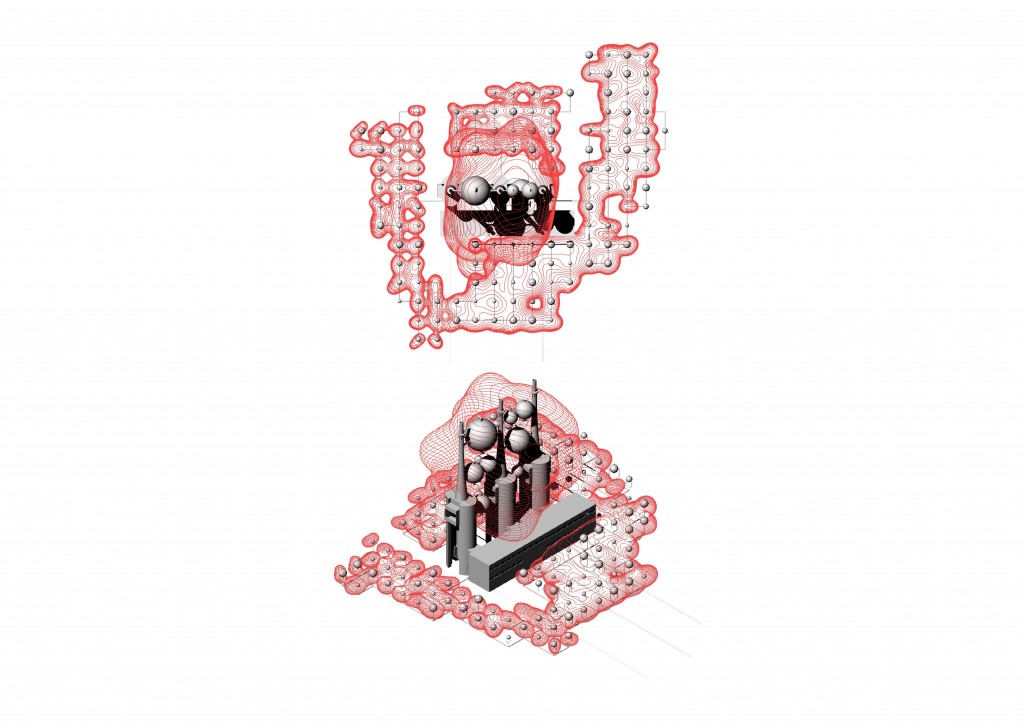 The materialities chosen for the project also play a fundamental role.
The materialities chosen for the project also play a fundamental role.
The mirrored surfaces look to create a fragile, floating aesthetic that almost disappears, but also distort, twist, and multiply the radial steam engines configuration in space. The steam acts as another element of discontinuity, disrupting the flow in space.
Finally, the project generates the same effect as sustainable architecture: it simulates an effect of modification but it really doesn’t produce any significant change.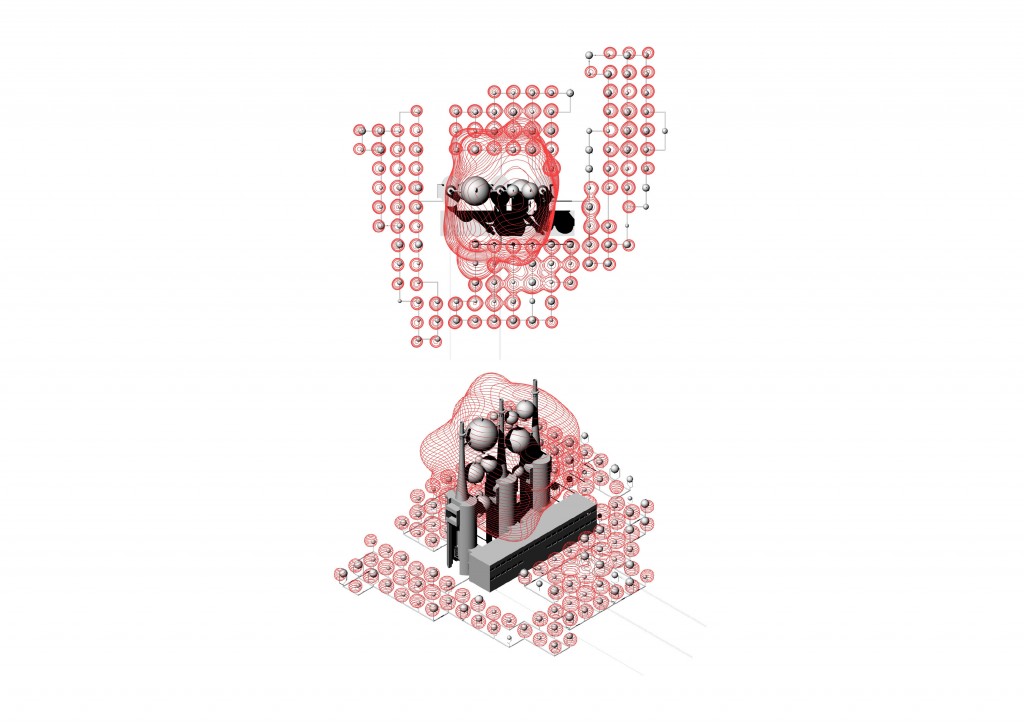
In conclusion Thermodynamic Infrastructure in the age of Global Warming is a “hyperstitional architectural object, which tries to loop back in time to performatively bring about its future existence, which has already happened…”
